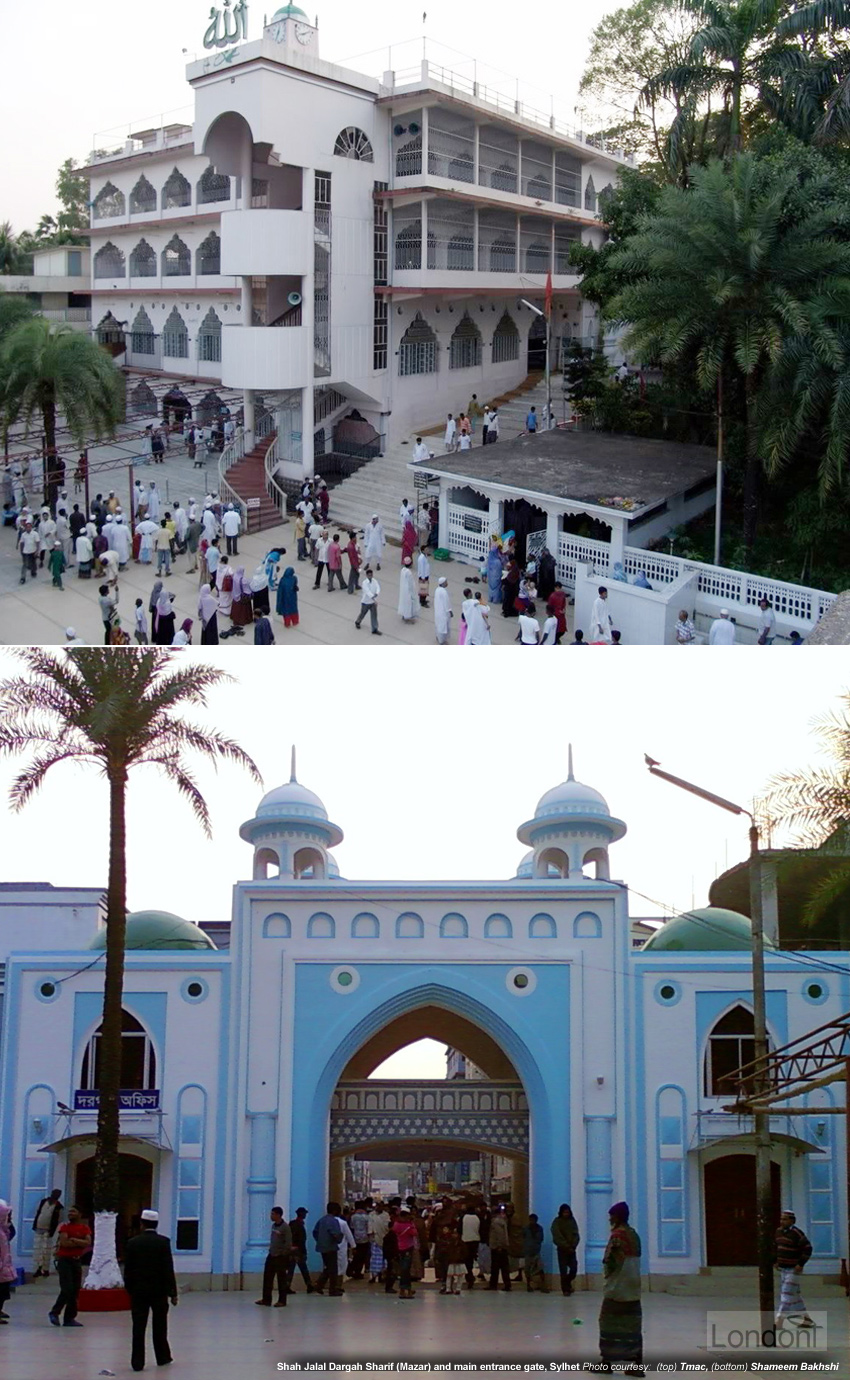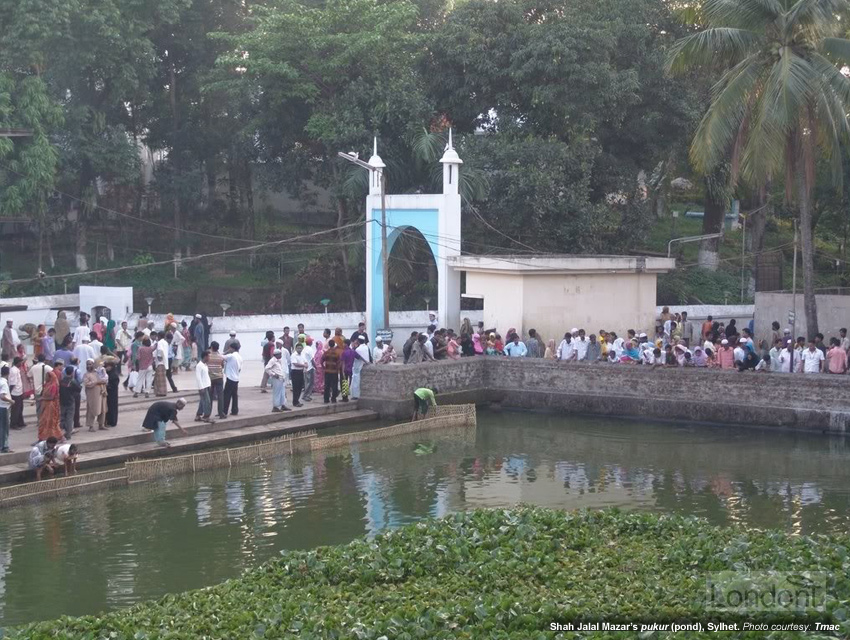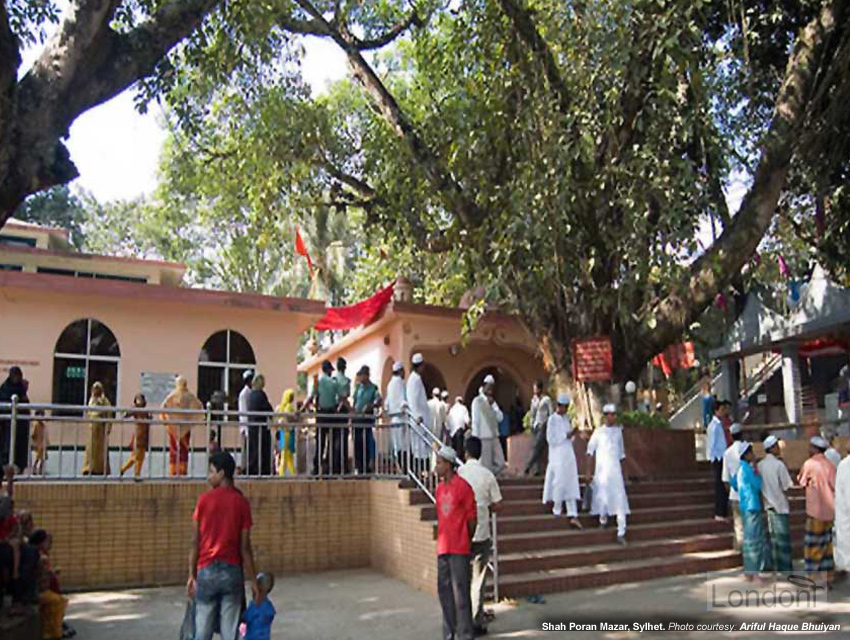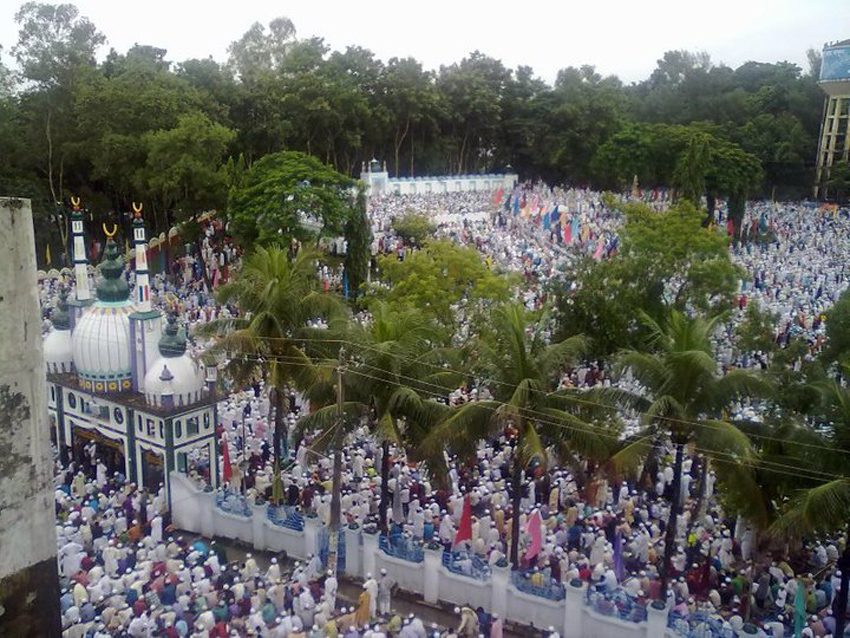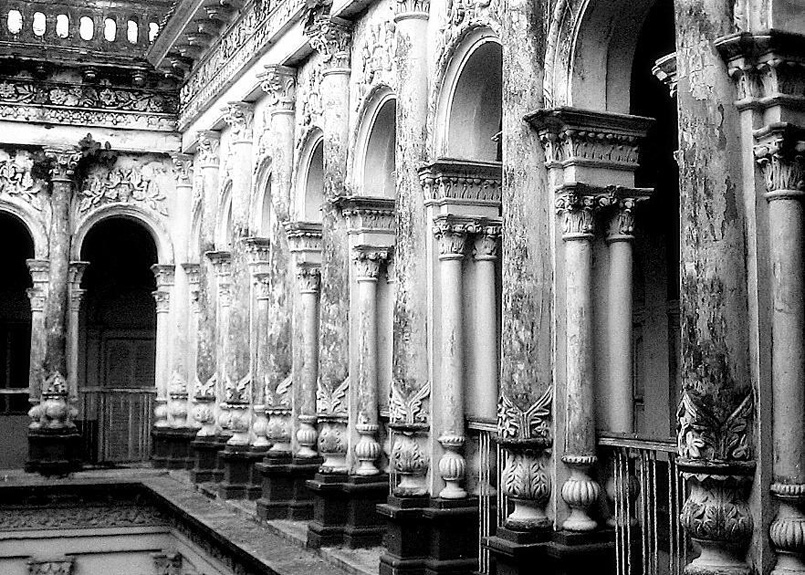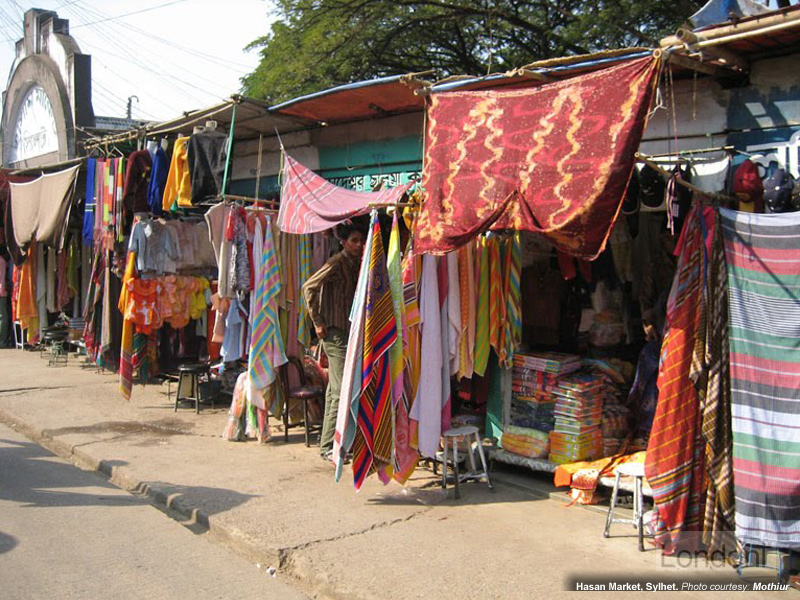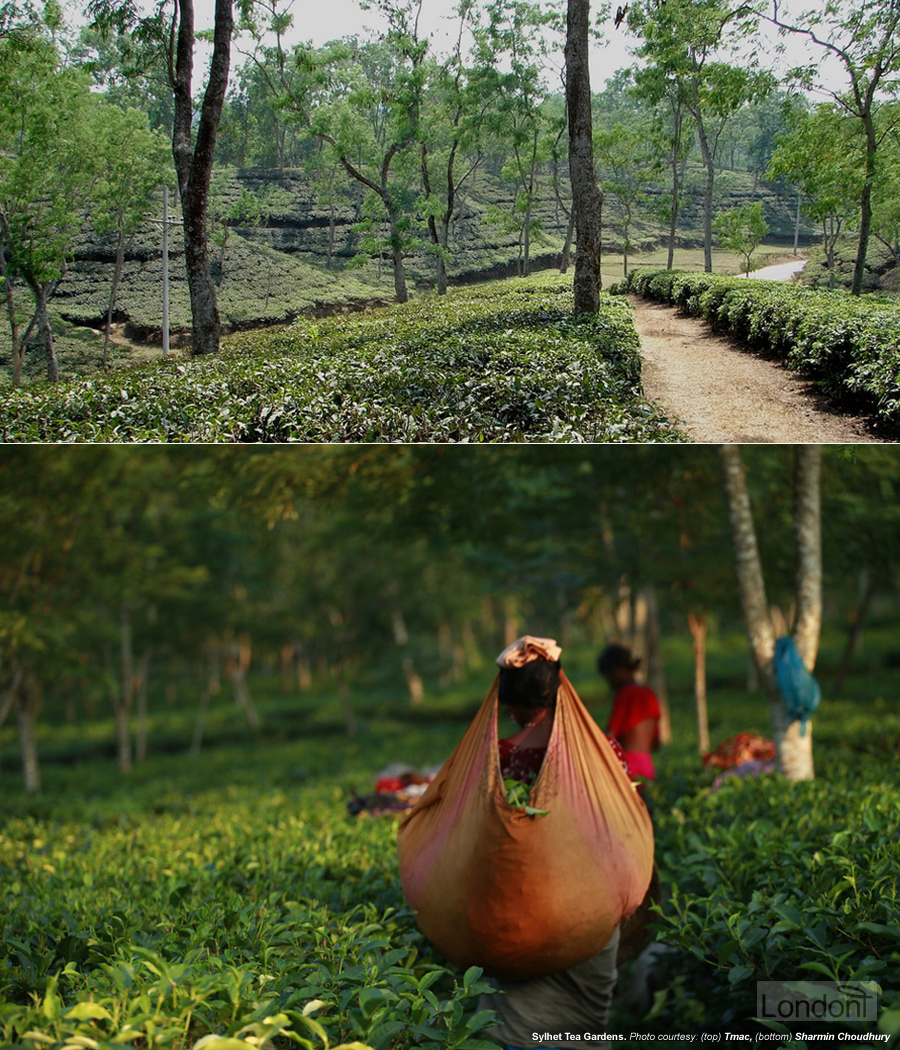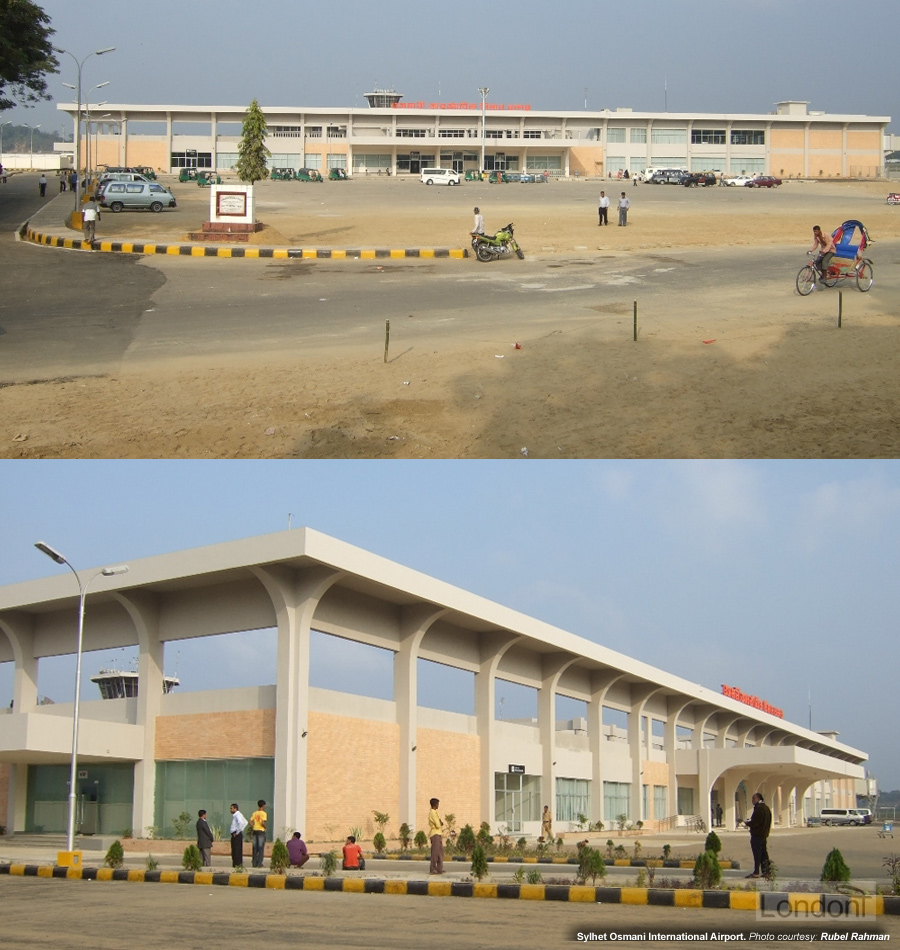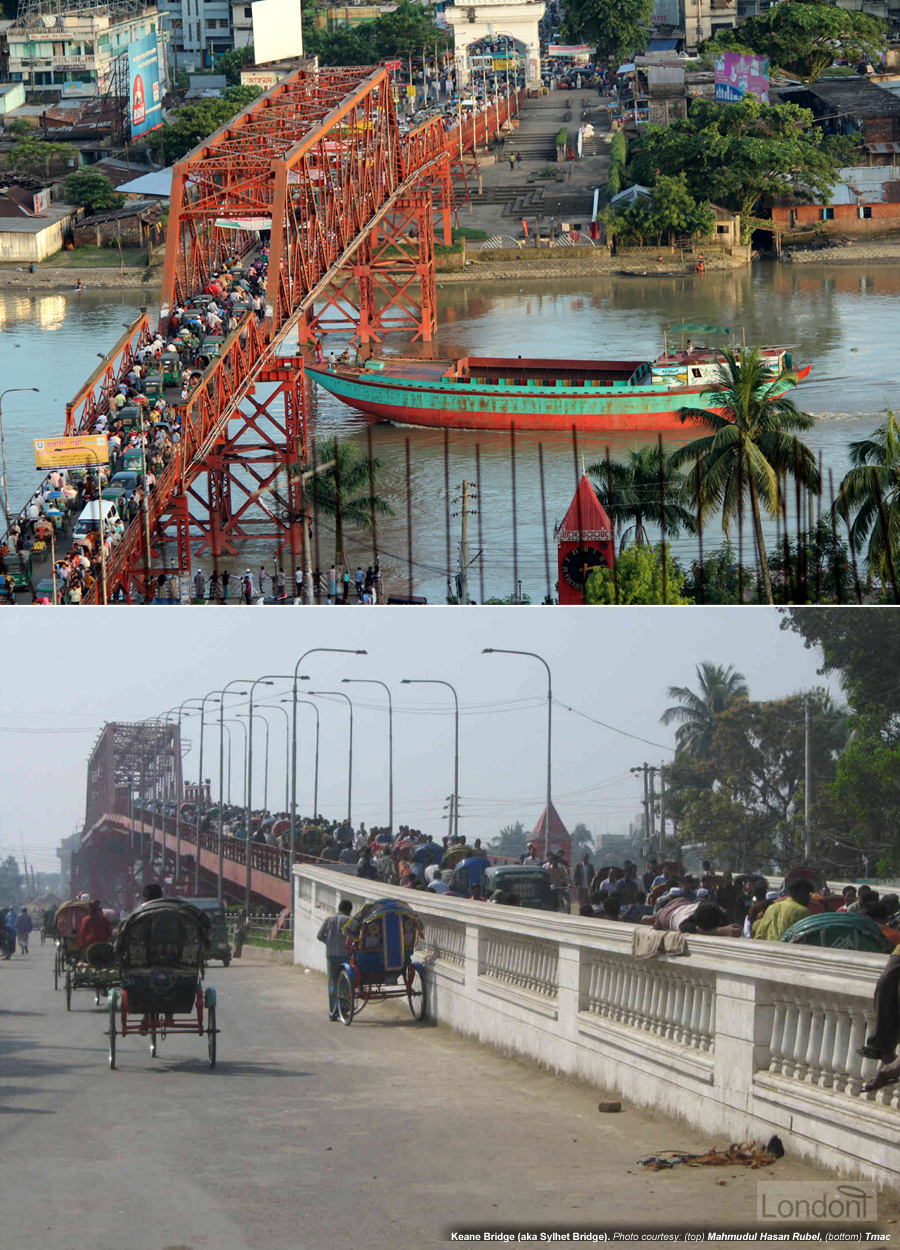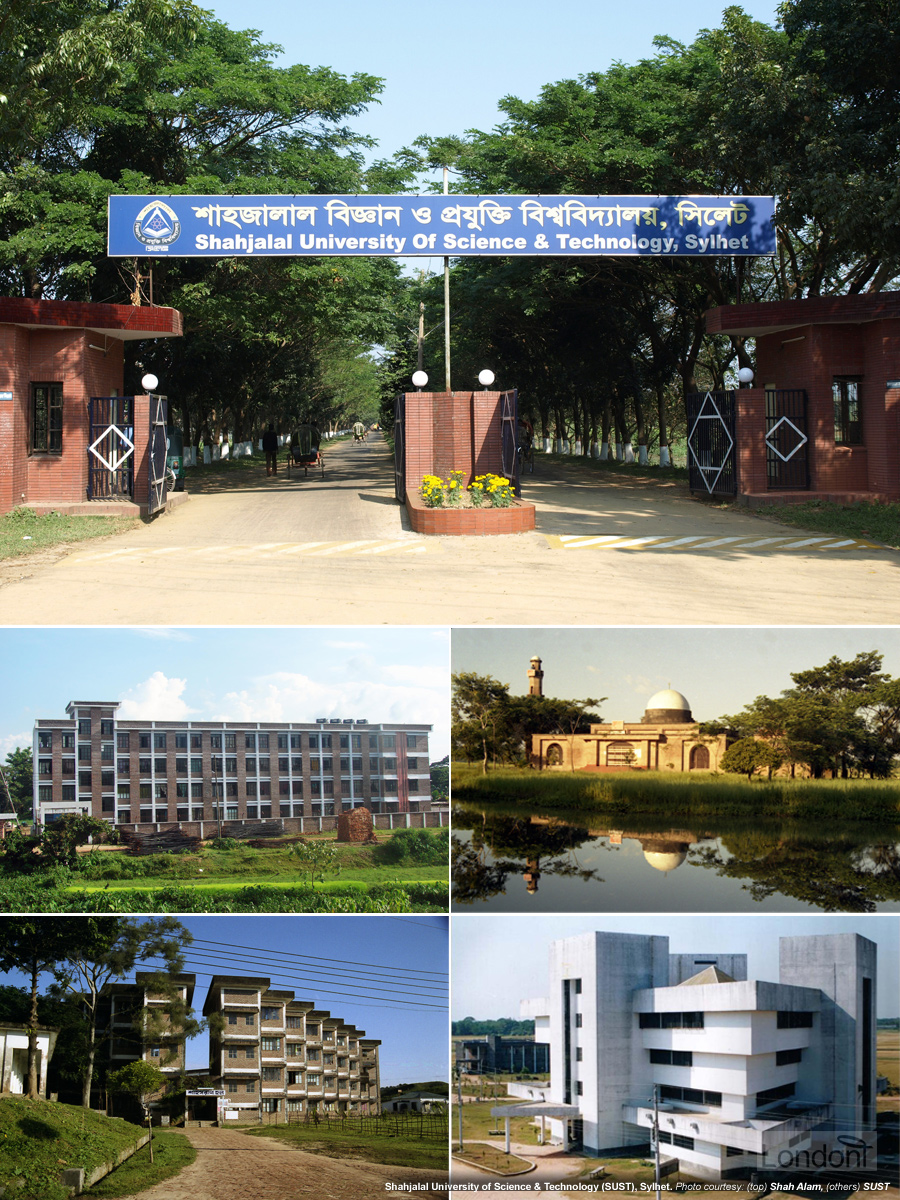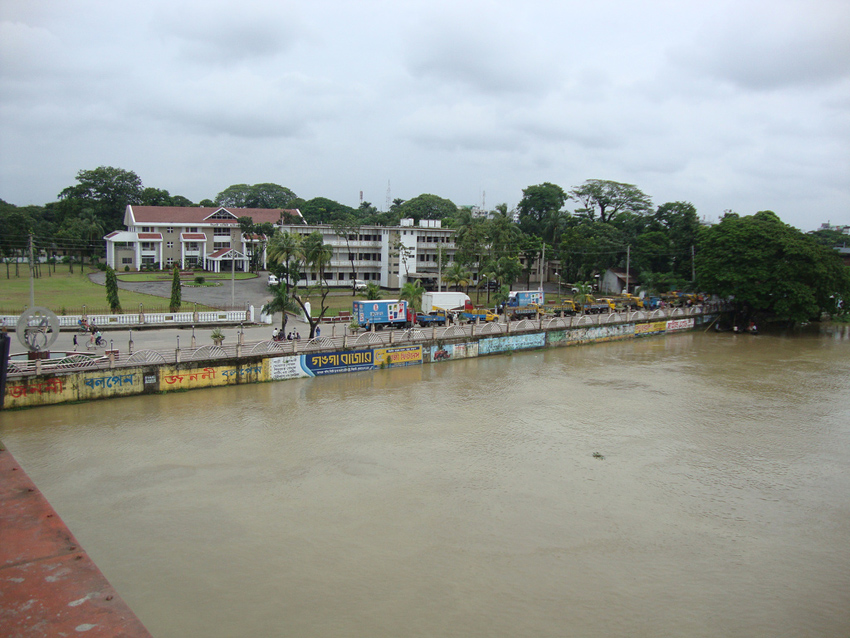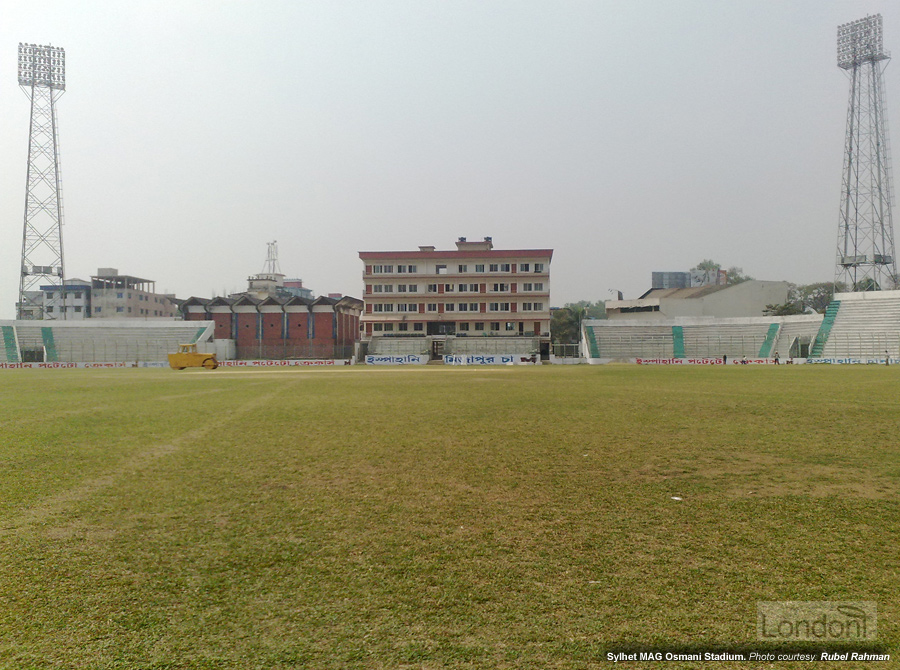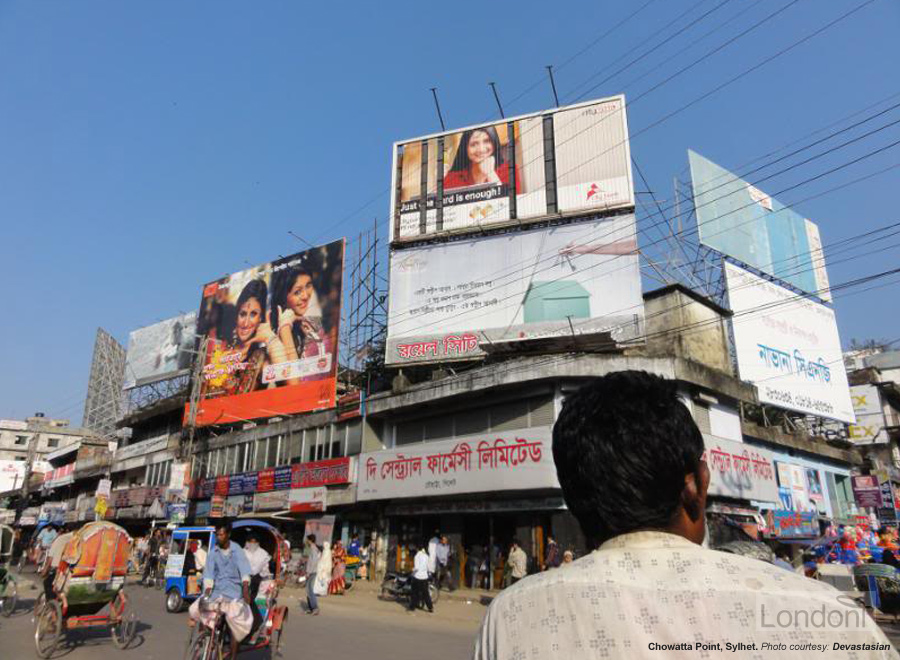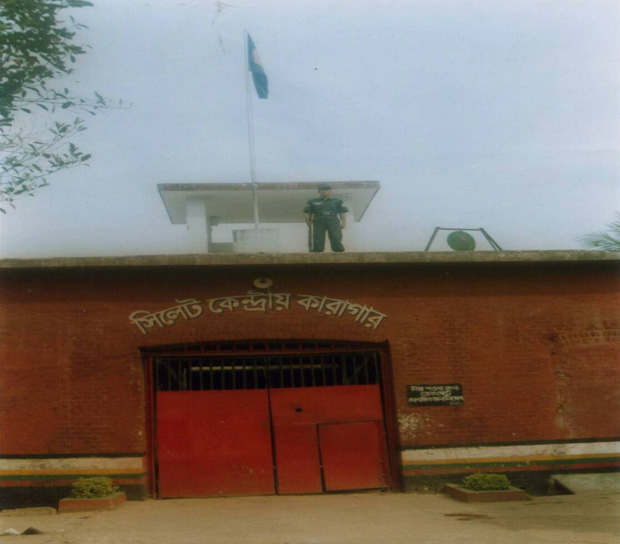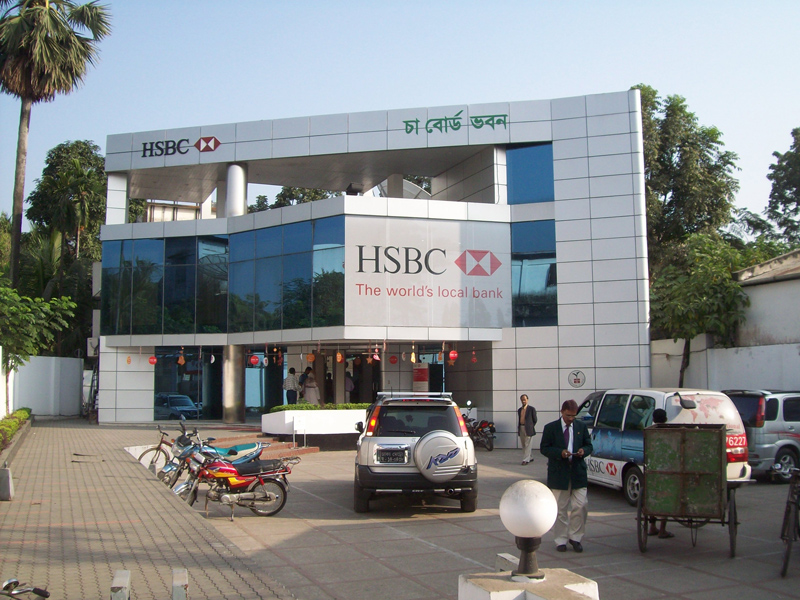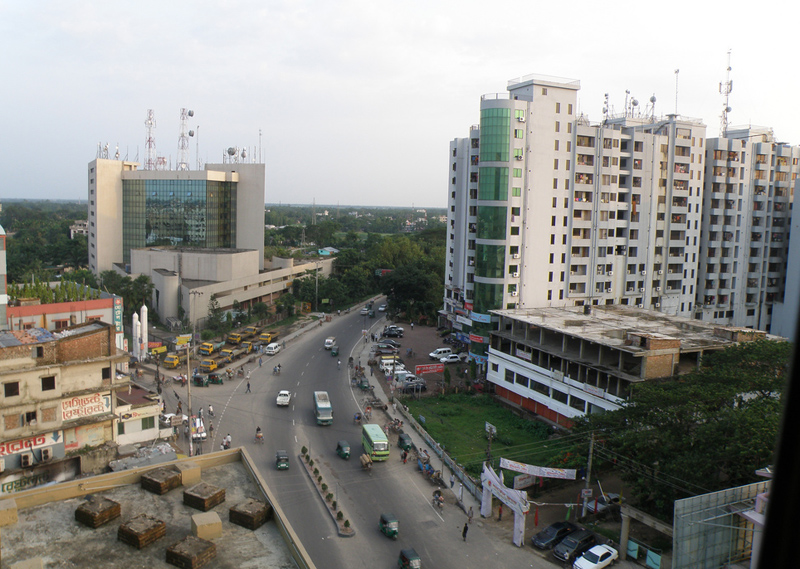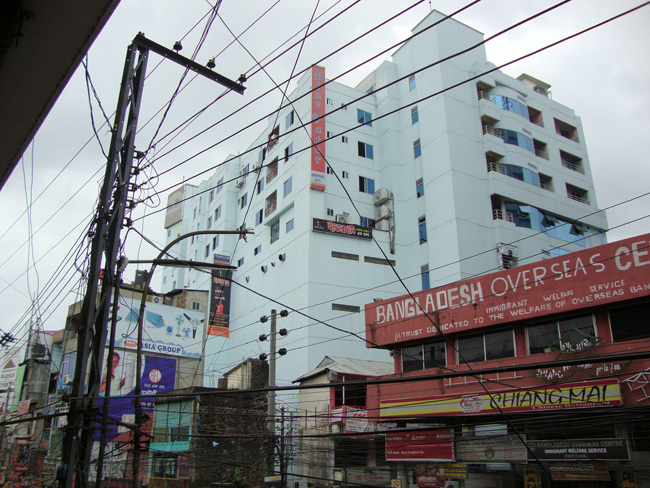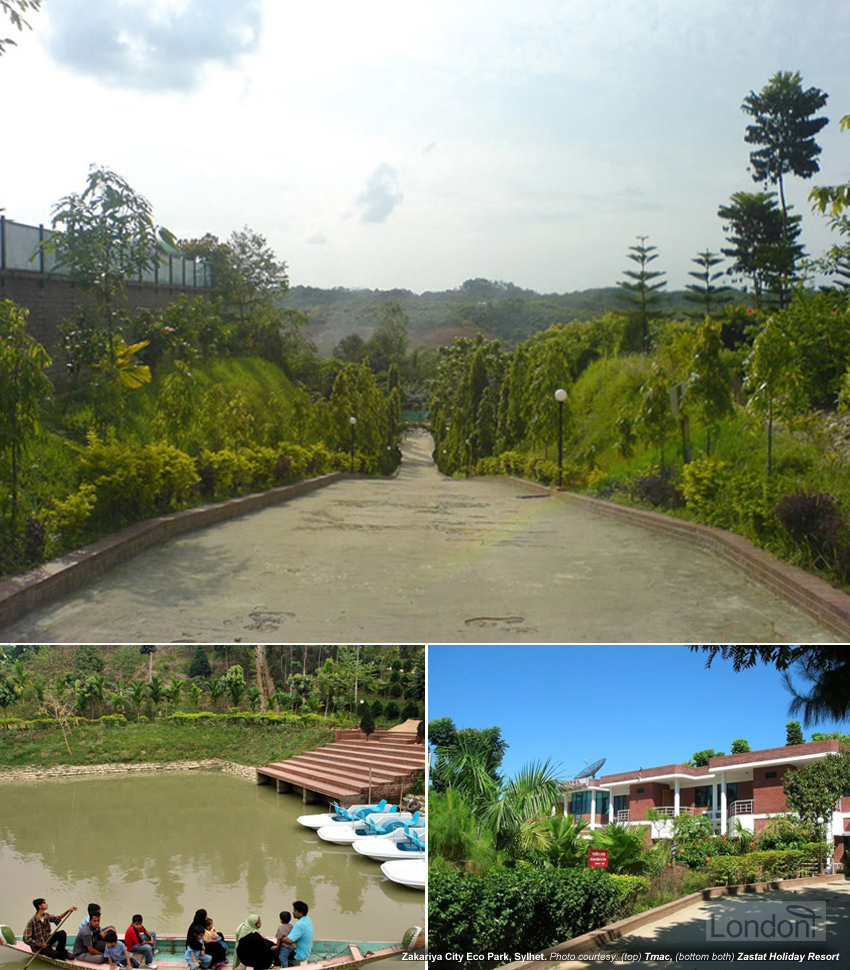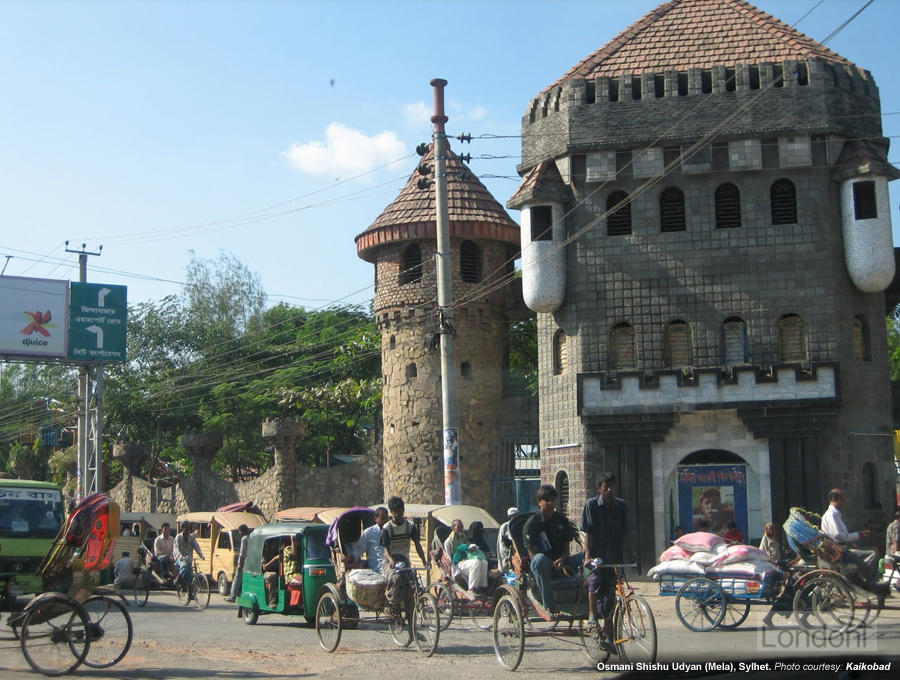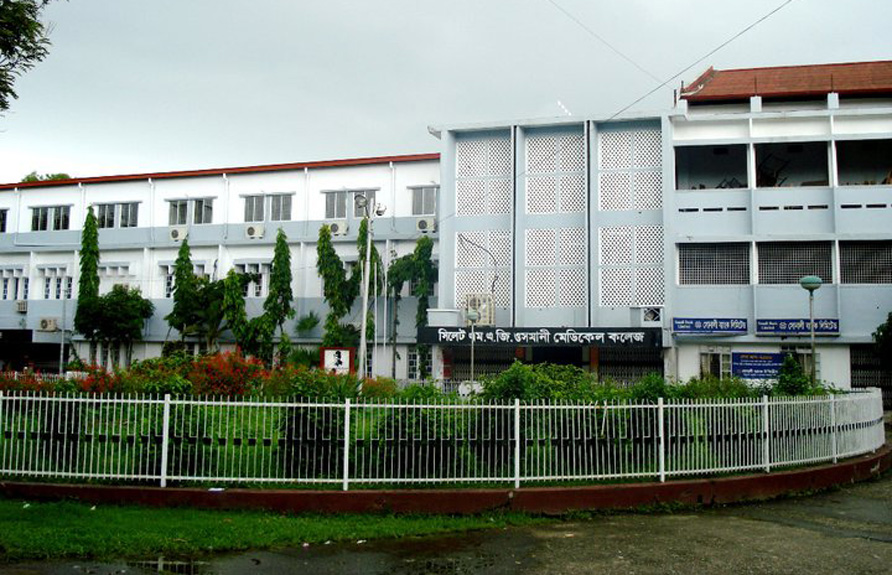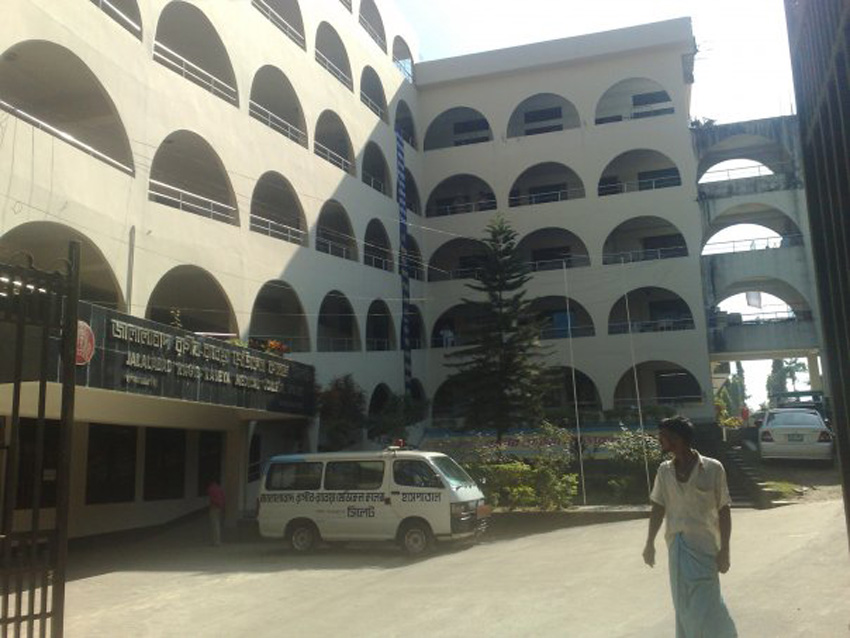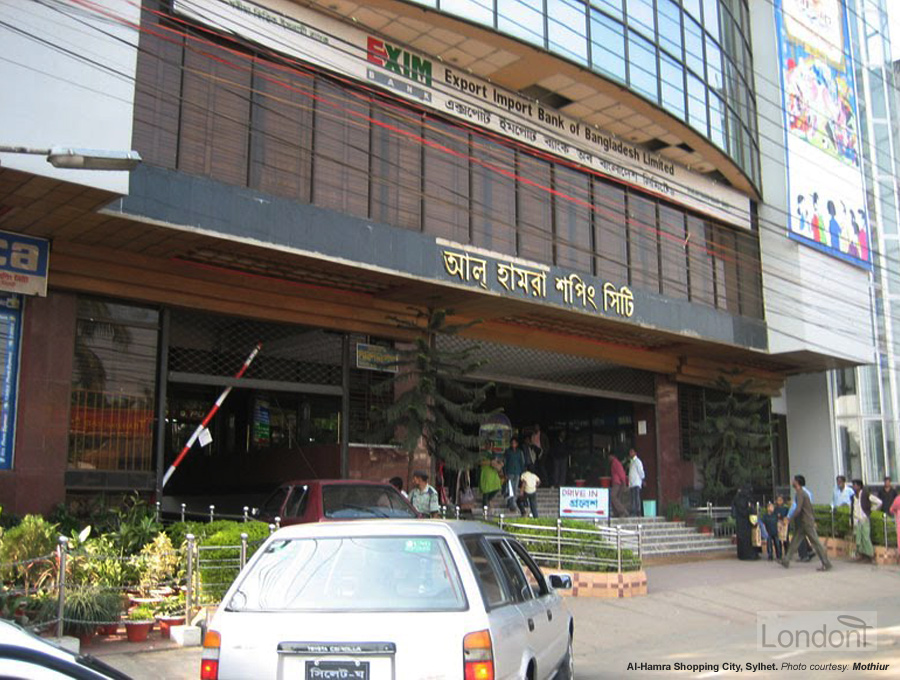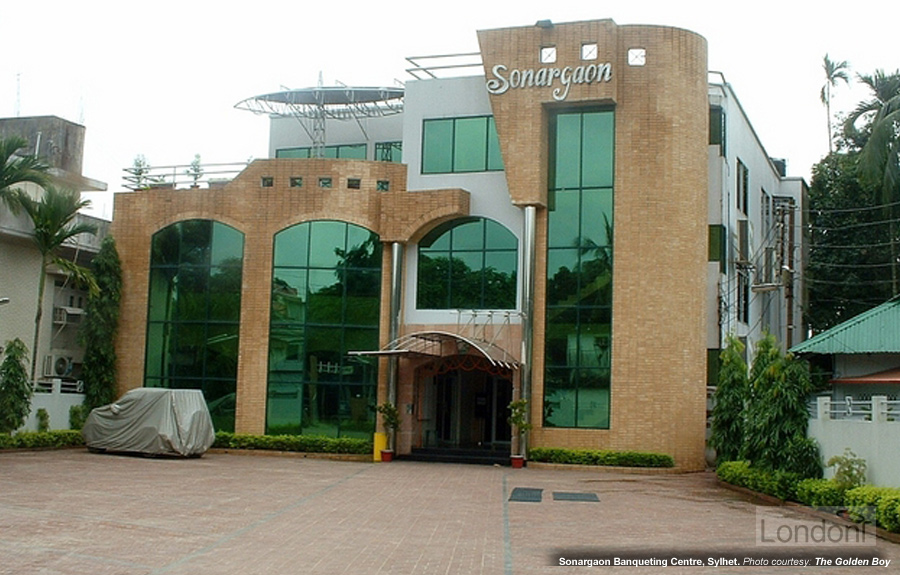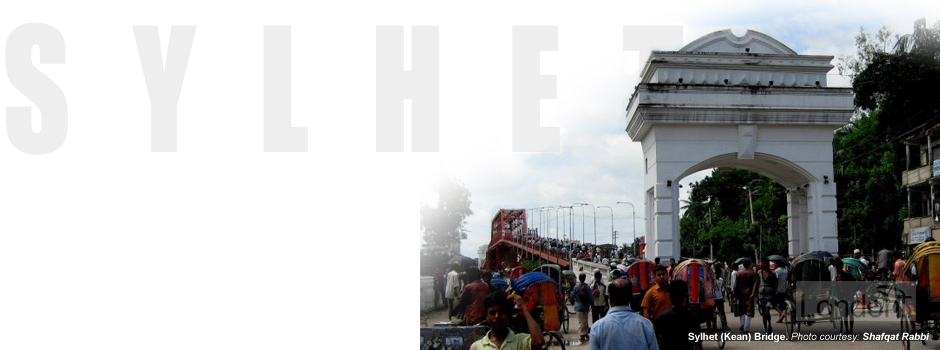
Introducing...Sylhet
Located on the banks of the Surma nodi, Sylhet city has a growing population of 500,000 people while also having a high population density. It is surrounded by Indian states of Meghalaya in the north, Assam in the east, Tripura in the south and the Bangladesh districts of Netrokona, Kishoregonj and Brahmanbaria in the west.
The area covered by Sylhet Division - also known as 'Greater Sylhet' - is 12,569 km², which is about 8% of the total land area of Bangladesh.
Beyond the Muslim (81%), Hindu (17%) and Buddhist and Christian (less than 1%) population which constitute the vast majority of Sylhetis, there are also more than 100,000 indigenous people - making up 1.5% of Sylhet Division’s population. The main ethnic groups in Sylhet are Khasi, Manipuri, Garo, Patro, Bishnupriya, Tripura and Santal. They are spread out throughout Sylhet and generally live below the poverty line.
Sylhet Division ('Sylhet Bibhag' in Bengali) is commonly referred to as just 'Sylhet'. This can arouse confusion, specially amongst non-Sylhetis since the city is called Sylhet, a district (zilla) is also called Sylhet and now the division is also called Sylhet!
Greater Sylhet is made up of four zillas (districts) - Sylhet, Sunamganj, Moulvi Bazaar, and Habiganj - and 38 thanas/upazillas (sub-districts), 334 union parishad, and 10,185 villages. It has approximately over 8 million people, which is less than 7% of the total population of Bangladesh.
13 thanas/upazillas (sub-district) of Sylhet Zilla (District)
- Balaganj
- Beanibazar
- Bishwanath
- Companiganj
- Fenchuganj
- Golapganj
- Gowainghat
- Jaintiapur
- Kanaighat
- Osmani Nagar
- Sylhet Sadar
- South (Dakhin) Surma
- Zakiganj
Sylhet Sadar is the largest of these thirteen upazillas.
Map of Sylhet
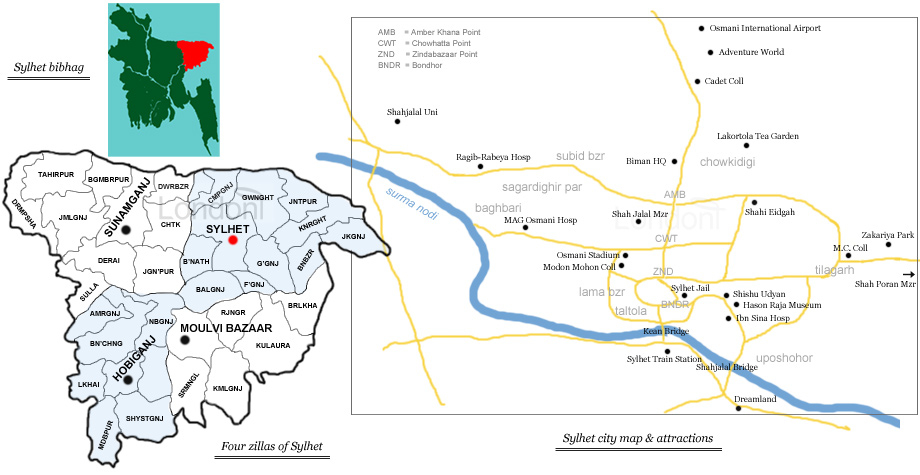
Sylhet from the air!
-
Ancient times: Brahmin 'Silhatta'
Historians believe that Sylhet was a commercial center from ancient period and had people of Brahmin, Assamese, Dravidians, Arabs, Persian, and Turks background. It was a Brahmin kingdom and controlled by rajas. Sylhet was certainly known by the rest of India, and is even referred to in the ancient Hindu sacred Tantric text, the Shakti Sangama Tantra, as 'Silhatta or Srihatta' ((Sanskrit word, meaning a prosperous centre of trading).
In the ancient and early medieval period, a large part of the then Laur, Goud and Jaintia states which now constitute Sylhet were ruled primarily by local chieftains as viceroy of the Koch kings of Pragjyotishpur (the city of ancient glory, and present-day Gauhati) of Assam. There is evidence to suggest that the Maharaja Sri Chandradeva, of northern Bengal, conquered Bengal in the 10th century, although this is a much disputed topic amongst Bangladeshi historians and archaeologists. This was a period of relative prosperity and there is little evidence to suggest this was marred by wars or feuds.
1303: Islam introduced by Hazrat Shah Jalal (Rahimullah) by defeating Raja Gaur Govind
After the decline of the Brahmin kingdoms tribal people of mongols took control of Sylhet. The last chief to rule over Sylhet was Govinda of Gaur, or Gaur Govind as he is commonly known, of the Tepra tribe of Tripura and the Sylhet area became known as Gaur Kingdom.
Shah Jalal arrives with his 313 / 360 auliyas (followers)
According to legend, in 1301 Raja Gaur Govind amputated a Muslim of Sylhet and killed his newborn son after a crow had snatched a piece of beef meat which the Muslim had sacrificed to celebrate his son's birth and dropped it at the King's temple (or a Brahmin's house), causing great offence to the King.
The Muslim sought justice from Sultan of Gaur who eventually approached Hazrat Nizamuddin Auliya, a highly influential sufi (dervish) in Delhi, India, in 1303. Hazrat Nizamuddin requested Sheikh Makhdum Jalal ad-Deen bin Muhammad, popularly known as Hazrat Shah Jalal, to aid the Sultan. Hazrat Shah Jalal came with his auliyas (followers), including his nephew Hazrat Shah Poran.
The exact detail of this historic event vary. For example, the birthplace of Shah Jalal (Yemen or Turkey), the number of auliyas (313 or 360), who conquered Sylhet (Shah Jalal or Sikandar Khan Ghazi, or both), etc.
The popular narration is Shah Jalal crossed the Sylhet's Surma nodi (river) by sitting on a jainamaz (prayer rug) and ordered the adhan (call to prayer). This shattered Gaur Govind's palace. The Muslim army then defeated the Raja and his army using Shah Jalal and his auliya's help.
Spreading Islam throughout the country
Having conquered the land, Shah Jalal and his auliyas settled in various places throughout the country such as Mymensingh, Dhaka, Comilla and various locations with Sylhet Division, in order to spread Islam. Shah Jalal himself settled in Sylhet city in the Choukidhiki area as the earth/mud of that area had matched the earth his uncle had given him.
In recognition of the outstanding achievements of these Muslims, Sylhet is often referred to as 'City of Saints' and considered to be the spiritual capital of the country.
Shah Jalal dargah sharif and Shah Poran Mazar
When Shah Jalal passed away around 1350 he was buried in Amberkhana area and a shrine (mazar) was created in his honour. This shrine is called 'Dargah-e-Shah Jalal', also known locally as Shah Jalal's dargah sharif or Shah Jalal's mazar.
Located in the Khadim Nagar area of Sylhet city is the Shah Poran mazar which was established by Shah Poran as a khanqah (spiritual retreat). It now contains a grand masjid alongside Shah Poran's shrine.
Both Shah Jalal and Shah Poran died as bachelors.
'Urs'
The Shah Jalal and Shah Poran mazars are popular venues for 'urs' (spiritual festival) each year and attract thousands of people from all over the country. They are packed during prayers, especially Jummah (Friday Prayer), and are top tourist attractions for Muslims and Non-Muslims.
1765: Source of revenue for British
Robert Lindsay, first Resident Collector of Sylhet
On 23 June 1757 the British East India Company (EIC) defeated Siraj-ud-Daulah, Nawab of Bengal, in the Battle of Plassey, near Kolkata, with the help of the treacherous Mir Jafar to establish their dominancy in India. In 1764 their military control was reaffirmed at Battle of Buxar when the EIC beat the combined armies of Mir Qasim (Nawab of Bengal), Shuja-ud-Daulah (Nawab of Awadh) and Mughal Emperor Shah Alam II. The subsequent treaty gained them the Diwani, the taxation rights, for Bengal and Bihar.
Sylhet officially came under the control of the EIC in 1765 but it took almost two decades for them to establish their dominance. In 1778 the EIC appointed Robert Lindsay as "Resident (tax) Collector" of Sylhet. He served as the first administrator of Sylhet until 1790. During this 12 year period Lindsay, a trader by profession, was deeply involved in commercial activities and made a personal fortune in a short span of time before retiring. His private business enterprise in limestone, controlling the cowry economy, and building boats made him extremely rich.
Lindsay, an enterprising Scot, was determined to fill the Company's coffers. But at the same time he meant to look out for himself. Shortly after arriving in Sylhet, he started trading in elephants and limestone, and within a few years made a personal fortune. His dual role as trader and governor, however, stirred discontent. The Muslims of India were still smarting from their recent losses at British hands, and the Sylhetis in particular yearned for freedom.
Syed Zain Al-mahmood, Journalist
In his autobiography Lindsay described in details the conditions of agriculture and manufactures. He reported that main attraction of Sylhet to the colonial government was chunam, rattan, elephants, fishes, timbers, betel nut, bamboo and so on. People from far flung districts used to come to Sylhet for fishes, timbers, betel nuts and bamboo. He described about the jungle state of Sylhet and presence of animals such as elephant, tiger, rhinoceros, leopard, deer, and wild fowl.
The leading families of Sylhet were stalwart Muslims, descendants of a long line of warriors and reformers beginning with Shah Jalal, the 'Saint of Kunya' and his companions. Lindsay himself regarded the tomb of Shah Jalal as a potential hotbed of resistance.
Flooding increases hostility towards British
Disaster struck the region in 1781 when a devastating flood wiped out the crop. The resulting famine killed almost a third of the population. Although Lindsay wrote to Fort William - East India Company's base in Kolkata - urging tax exemption, the locals blamed the British for failing to prevent the catastrophe. There was an uprising, led by brothers Syed Muhammad Hadi and Syed Muhammad Mahdi (known locally as Hada Miah and Mada Miah), sons of a prominent local religious family. In his memoire "Anecdotes of An Indian Life", Lindsay simply refers to the leader of the rebellion as "Pirzada" - literally, "son of a religious leader".
In 1782, Lindsay and his army faced the Pirzada's followers near the site of the famed Shahi Eidgah in Sylhet. The rebels, armed with swords and spears, were no match for the firepower of the British. Although they fought gallantly, the uprising was swiftly quelled and the Pirzada was killed in battle. In his book Lindsay recalls how he lived in fear of revenge attacks by the Pirzada's followers for as long as he remained in Sylhet.
In the month of Muharram of 1782, two religious leaders, Syed Mohammad Hadi and his brother Syed Mohammad Mahdi along with their followers revolted against the British from this ground. Robert Lindsay, the then British Collector of Sylhet shot these brothers dead to foil the revolt against the British. This was even before the great revolt by Titumir. On that fated day in 1782, Syed Hadi and Syed Mahdi along with their followers gathered there with a Muharram procession. They planned to attack the British all on a sudden. But, things went wrong as the collector through his spies got the message ahead of the day. Lindsay reached the field along with a contingent and asked the people to surrender their arms. But the two brothers and the follows declined and revolted. At one stage of the long fight, Syed Hadi was shot dead by Lindsay. Hadi's brother-Mahdi also embraced martyrdom along with some others after a long fight. Robert Lindsay, who had served for about 12 years in Sylhet, also narrated the sad incident in his memoirs that he wrote on his return to England.
Syed Ullah's revenge mission in Britain ends with him making a curry for Robert Lindsay!
Robert Lindsay served in Sylhet for 12 years. By 1809, Robert Lindsay was back home in Britain leading a life of retired luxury. One day, while out riding, he spotted an Indian by the side of the road. On questioning, the man said he had arrived on a merchant vessel from Bengal. It turned out he was from Sylhet, and so Lindsay invited him to his mansion. The man, Syed Ullah, said he was looking for a Briton named "Lindsay". "When I told him who I was, he looked at me with hatred in his eyes. 'So it was you who killed Pirzada!'".
Syed Ullah had come to avenge Pirzada's death. Lindsay expressed regret and explained that he was doing his duty on that day. It is not clear how, but the wily Scot managed to gradually defuse the tension. After the two had made peace, Lindsay asked Syed Ullah if he could cook curry. The Sylheti man replied that curry was his specialty and he usually carried some spices with him. Lindsay requested Syed Ullah to whip up an "Indian" meal. Lindsay writes in his memoirs that his family members begged him not to eat anything cooked by the oriental man. His children's governess had apparently dreamt that a black man had poisoned the entire family. Lindsay, however, was unmoved. "Never was a curry better dressed,” he wrote in Anecdotes, "and never did I have a better meal."
This strange incident may have been embellished slightly by Robert Lindsay, but it is actually the first specific report of a Sylheti in Britain. It is all the more remarkable because it brings together several of the threads that run through the early part of the British Bangladeshi narrative colonialism, the sea, and curry.
Sylhet's maritime past has been all but erased. Ask a local man about the seafaring "Sarangs" of old and you are likely to get a blank look. But it was not too long ago that names like Ayub Ali Master, Surab Sarang and Chowdhry Sarang were household names in the Sylhet region. The name "Sarang Bari" (Mariner's Home) harks back to a forgotten era in Sylhet's history. Very rarely one meets an old-timer whose eyes will light up at the mention of those names. "Ahhh, those Jahaji (sailor) folk! They were brave men!"
Syed Zain Al-mahmood, Journalist
1782: Sylhet Zila (Sylhet District)
Prior to 1782 Sylhet was under the direct control of the Dhaka (then spelt Dacca) sub-provincial administration. In order to release work pressure in the Dhaka province, Sylhet was separated into an administrative unit and made independent of Dhaka zone and on 3 January 1782 the Sylhet Zila (Sylhet District) was established by the Provincial Committee’s letter. Initially, the Company allowed the Faujdar (Administrators) of Sylhet to administer the area with limited power https://books.google.co.uk/books?id=M_BtAAAAMAAJ&hl=en&sa=X&ved=0ahUKEwjhtMCb1KjcAhVO-qQKHQ1eDq4Q6AEIKTAA.
But Sylhet still remained under the jurisdiction of Dhaka Division.
1824 - 1826: Strategic importance for British rule, especially during First Anglo-Burmese War
Since the late 18th century the East India Company was cautious about Burmese imperialist plans in Assam, Manipur, Sylhet and Chittagong – areas considered the 'frontiers' of colonial Bengal. In 1824 war broke out between Burma and the Company. Known as First Anglo-Burmese War (5 March 1824 – 24 February 1826), it ravaged Manipur and Cachar, to the east of Sylhet.
Prior to the war, Sylhet had a lower priority for the British administration. But now EIC became interested in Sylhet and saw it as an area of strategic importance in the war against the Burmese. One of the military priority of the EIC was also to find a link to China through north-eastern Bengal. Sylhet was the point of access to these possible networks imagined by the EIC. Thus Sylhet became part of British control and administration and was governed as a part of Bengal. The EIC launched a three-ponged attack against Burma, namely from Assam, Sylhet and Chittagong-Arakan. After two years of fighting, the war ended in a decisive British victory and the Treaty of Yandaboo was signed in 1826.
During this period the commercialisations of Sylhet tea plantations under Company rule also took place, especially after 1834 when the EIC lost its monopoly over the tea trade from China. By late 18th century there was a significant presence of British merchants in Sylhet.
1874: Become part of Assam
Prior to 1874, the British ruled Assam (located north-east of Bangladesh) as an 'appendage' of Bengal. However, in 1874, for administrative reasons, Assam was separated from Bengal and placed under one Chief Commissioner. On 12 September 1874 the East Bengal district of Sylhet – historically unconnected to Assam – was included in the newly created Assam Province. The districts of Cachar, Goalpara, and Garo Hills were also merged with Assam.
The primary goal of making Assam into a new administrative entity was to find an inexpensive and effective way to administer the area. Considerations of historical continuity or cultural contiguity were not in the minds of colonial officials.
1897: New Sylhet built after Great Assam earthquake
On 12 June 1897 Assam was struck by natural disaster. A powerful earthquake, measuring over 8.0 on the Richter scale https://books.google.co.uk/books?id=_WVIAAAAQBAJ&pg=PA109&hl=en&sa=X&ved=0ahUKEwjZgMas16jcAhWFjKQKHTUEAn4Q6AEIRDAF, hit Assam. The Attrabari, Rambrai and Shillong areas were the most devastated. It demolished the northern area of East Bengal, from Rangpur and Natore to Moulvi Bazar. Sylhet and Mymensingh regions experienced severe damage. The tremor was felt less strongly over much of South Asia, including lower Myanmar (also known as Burma), the Assam valley and much of the Indian subcontinent.
It was the first Indian earthquake for which levels of shaking were documented in a contemporary earthquake report https://books.google.co.uk/books?id=_WVIAAAAQBAJ&pg=PA109 &hl=en&sa=X&ved=0ahUKEwjZgMas16jcAhWFjKQKHTUEAn4Q6AEIRDAF.
Following the demolition of Sylhet a modern and European model new town was built on the wreckage. Many new roads were constructed in the late 1890s and Sylhet became really connected to the other parts of the country with the establishment of an extension line of Assam–Bengal Railway in 1912-15. From the very beginning of the 20th century, the importance of Sylhet increased with the establishment of the tea industry.
1905 - 1911: Assam Province include Dhaka, Chittagong and Rajshahi during Partition of Bengal
Following the partition of Bengal in 1905 – known as 'Banga Bhanga' in Bengali - the territorial entity of Assam also embraced the districts of Dhaka, Chittagong and Rajshahi divisions of Bengal and the state was placed under one Lieutenant Governor. But six years later when the partition was annulled in 1911, Assam was separated from Bengal and again placed under one Chief Commissioner.
1926: Campaign to keep Sylhet part of Assam
The inclusion of Sylhet in Assam created challenges on the religious and linguistic fronts. Firstly, Assam is predominantly a Hindu-majority province whereas the district of Sylhet is Muslim-majority area. During that time, the Muslims constituted 60% of Sylhet's population https://books.google.co.uk/books?id=YRyAAgAAQBAJ&pg=PA176 &hl=en&sa=X&ved=0ahUKEwij3p_qxa3cAhWQyKQKHSNvAq0Q6AEILTAB. Secondly, Sylhet has a predominantly Bengali speaking population, whereas the Assamese speak mainly Hindi.
Inclusion of Sylhet in Assam created some serious social problems as the English educated class among the Bengalis from Sylhet came to occupy the bulk of the positions in Assam's colonial bureaucracy, which was resented by the Assamese. The origins of the Bengali Assamese conflict in Assam in later years had its origin in the rivalry between the inhabitants of the Surma valley – inhabited predominantly by Bengalis – and those of the Brahmaputra valley – predominantly Assames. Sponsored migration of Bengalis to Assam further fuelled these rivalries, as migration from Bengal to Assam became quite significant during the second decade of the 20th century.
The Bengali-Assamese divide was, to some extent, diluted by the Hindu-Muslim divide, when the idea of a separate Muslim nationality appeared on the political scene, and, at least for a short period, the idea of Muslim nationalism produced a unity between the Assamese and Bengali Muslims.
In January 1926 when the Assam Council debated the separation of Assam from Sylhet, an influential representative from Sylhet, Dewan Wasil Chowdhury, opposed it as did Saadulla, an influential Assamese Muslim leader. In fact, the provincial Muslim League Council of Assam was formed, primarily, to mobilise Muslim opinion against the transfer of Sylhet to Bengal, although the majority population – in both the valleys – supported the proposal for separation https://books.google.co.uk/books?id=Nyk6oA2nOlgC&pg=PA212&hl=en&sa=X&ved=0ahUKEwj0g8js5q3cAhUK6KQKHZKyAXgQ6AEILjAB. The British Government did not favour the idea also, as it could have given an impetus to similar other demands for the change of boundaries, upsetting the political status quo, and especially the Hindu Muslim demographic balance.
Thus Sylhet remained part of Assam Province from 1874 to 1947, i.e. over 70 years, until British India was divided into India and Pakistan.
1947: From Indian Assam to East Pakistan
Sylhet Referendum
In 1947 a referendum was carried out to decide whether Sylhet should continue to form part of Assam province or be amalgamated with the new province of East Bengal as part of the soon to be created country of Pakistan. Interestingly, the British Government gave the power for people of Sylhet to decide their fate themselves by voting, whereas Bengal and Punjab was not given that option and was divided primarily by the demographic complexion of the provinces.
Sylhet zila was in the grip of referendum fever. Muslim League, headed by Muhammad Ali Jinnah, campaigned for Sylhet to be part of new 'Islamic nation' while Congress Party, led by Jawaharlal Nehru, campaigned for it to remain part of Indian Assam. But they were poles apart in their effort.
Congress Party appeared to confine its responsibility in dealing with the referendum in Sylhet largely to negotiating with the Viceroy and his associates at the highest level of administration. None of their representatives visited the area during the preparation of the referendum https://books.google.co.uk/books?id=YRyAAgAAQBAJ&pg=PA176&hl=en&sa=X&ved=0ahUKEwij3p_qxa3cAhWQyKQKHSNvAq0Q6AEILTAB. In contrast, the Muslim League formed a Committee of high profile members such as the powerful, charismatic and passionate Bengali Maulana Bhashani, and even sanctioned adequate funds at the behest of Jinnah.
The referendum was held on 6 and 7 July 1947. Over 56% or 239,619 voters were in favour of Sylhet becoming a part of Pakistan while less than 44% or 184,041 voters https://books.google.co.uk/books?id=YRyAAgAAQBAJ&pg=PA176&hl=en&sa=X&ved=0ahUKEwij3p_qxa3cAhWQyKQKHSNvAq0Q6AEILTAB wanted it to remain a part of undivided Assam in India. The result was not unexpected as it almost reflected the demographic composition of the district’s population.
The Sylhet referendum was virtually a vote on the twin issues of the reorganisations of India on a communal basis and of Assam on a linguistic basis. The Hindus, who had for decades agitated for amalgamation with Bengal, voted to remain in Assam, while the Muslims who had opposed the division of Assam till 1928, supported the partition.
There were complaints and allegations of voting irregularities and bogus votes, notably from Congress leader Jawaharlal Nehru, and a demand for a fresh referendum. However, despite serious doubts, no attempt was made to organise a protest movement, presumably because 'no one outside Sylhet is particularly anxious to retain the district in Assam'. Even Nehru accepted the verdict.
Keeping in mind the poll outcome, Nehru recommended the transfer of the entire district of Sylhet to east Pakistan with the exception of three thanas of Badarpur, Ratabari, Patharkandi and a portion of Karimganj thana. The Muslim League accepted this request. With that Assam lost nearly one-third of its population, along with its vast paddy lands and the tea, lime and cement industries of Sylhet. Major portion of the Surma valley was also lost and only a remnant of this old natural division remains in divided Assam.
Part of Chotrogram (Chittagong) Division
As a result of the referendum, Sylhet became a district in the eastern wing of Pakistan known as 'Purbo Pakistan' (East Pakistan) in Bengali. It was put under Chotrogram (Chittagong) Division and remained so till 1995.
1971: City of Saints becomes third major city of Bangladesh
As a result of the 1971 Mukhtijuddho (Independence War of Bangladesh) East Pakistan became the newly formed independent country of Bangladesh - and Sylhet became it's third major city after Dhaka and Chotrogram.
A number of great personalities like Rabindranath Tagore, Poet Nazrul, Mahatma Gandhi, Moulana Mohammad Ali, Moulana Shaokat Ali, Hossain Shahid Suhrawardy, Sher-e-Bangla AK Fazlul Haque and Manik Bandopadhyay visited Sylhet on different occasions.
Iqbal Siddiquee, Journalist
1983 - 1984: Greater Sylhet divided into 4 zillas
During the 1983 - 84 period Greater Sylhet was divided into four new districts or zillas:
- Sylhet - north-east section
- Sunamganj - north-west section
- Habiganj - south-west section
- Moulvi Bazar - south-east section
1995: Sylhet Bibhag (Sylhet Division)
On 1 August 1995 Sylhet broke away from Chotrogram bibhag and was declared as the 6th division of the country - 'Sylhet Bibhag' or Sylhet Division, consisting of the four zilas of the greater Sylhet. This change increased the status of Sylhet even more. The Divisional Commissioner of Sylhet was given responsibility of acting as the chief revenue officer and coordinator of divisional government offices.
Today, the Sylhet Division along with Barisal, Chittagong, Dhaka, Khulna, Rajshahi, and Rangpur divisions make up the whole of Bangladesh.
2001: Sylhet City Corporation
On 9 April 2001 Sylhet city was upgraded into City Corporation having been a municipality since 1878, i.e. for 123 years. However, the Sylhet municipal board itself was established eleven years earlier in 1867.
2009: Metropolitan status
On 31 March 2009, seven years after gaining Corporation status, Sylhet was granted metropolitan city status along with Barisal.
Metropolitan city, or metropolis, is a term generally used to represent a large urban city. By becoming established as a metropolis in 2009, Sylhet became acknowledged nationally and internationally as a center of economic, political and cultural importance to Bangladesh.
At Present: 'Londonies' drive economy
The main economic development of Sylhet Bibhag is carried out by British Bangladeshis, commonly referred to as 'Londoni'. Over 95% of the bengalis in Britain come from the Sylhet region and they invest largely to the development of Sylhet.
During the fiscal year of 2005-06, the flow of remittances increased by 25 % to $4.8 billion, mostly from expatriates of Sylheti origin living in the United Kingdom with significant contributions from expatriates in the United States. That amount was expected to increase to $5.5 billion in 2007, with the government's attention toward supervising and monitoring banks.
Booming investment
The construction industry in Sylhet is currently booming, with many shopping centres and apartments being built to luxurious standards. The skyline of the city is mainly dominated by large buildings of western-style shopping malls, which has been the largest investments made by the expatriates. There are many new restaurants and stores, often themed on those found in London, which have been established to cater to the visiting Sylheti expatriate population and the growing Sylheti middle classes. These include, Garden Tower in Uposhohor, the London Mansion, Sylhet Millennium, Blue Water (named after Bluewater Shopping Complex in the UK), London Fried Chicken (from Perfect Fried Chicken) and Tessco (misspelt from the original Tesco).
New hotels have been established, the Rose View Hotel (in Uposhohor) and the first Apartment-Hotel and resort in Bangladesh, called Grand Sylhet (near Osmani International Airport), are both the only five-star hotels in the city.
But,new matters of concern are awaiting the people here. The geologists and other scientists say the Sylhet region falls within the most earthquake prone zone of the country. During the last 150 years three major earthquakes (surface-wave magnitude larger than 7.5 on the Richter Scale ) have occurred in this area. But local people are not that aware of the seismic status of the region. Since the last catastrophic earthquake occurred in 1918, very few people remember it.
The experts clearly say a strong earthquake affecting a major urban centre like Sylhet may result in damage and destruction of massive proportions and may have very long term consequences for the entire country. Like most major urban centres in our country, Sylhet has grown tremendously in the last few decades due to unabated migration from the smaller towns and rural areas. As a result, the city has developed in an unplanned way with little consideration for proper town planning norms. Moreover, about 80 per cent of the buildings were constructed without following the building code.
Iqbal Siddiquee, Journalist
Sister city
In order to foster greater cultural and commercial tie many cities across the world will link up and become 'Sister cities' or 'Twin towns'. This is usually a community led partnership though support are also provided by the government.
Sylhet is Sister cities with:
- Tower Hamlets, London, UK
- City of Westminster, Marylebone, London, UK
- St Albans City & District Council, Hertfordshire, UK
- Rochdale Metropolitan Borough Council, Greater Manchester, UK
- Amman, Amman Governorate, Jordan
Source: Wikipedia - Sylhet
-
Places of worship & mazars (shrine)

Shah Jalal Dargah Sharif (Mazar): Contains the tomb of Hazrat Shah Jalal ad-Din al-Mujarrad - a Yemeni sufi who came to Sylhet with 360 followers, including his baghna (nephew) Shah Poran, to preach Islam and help the Muslims. His shrine is famous throughout Bangladesh with hundreds of devotees visiting daily. He was a lifelong bachelor who settled in Choukidhiki area. Bangladesh's main airport Shahjalal International Airport in Dhaka is named in honour of him. It's commonly believed that it is his blessing why 95% of UK Londonis come from Sylhet bibhag.
Shahjalal Mazar's pond:Legend has it that Hazrat Shahjalal (Rahimullah) transfomed the witchcraft followers and family members of Raja Gaur Govind into catfishes which are still alive in the pond of the mazar. Visitors to the shrine throw small fish for the catfish to eat.
Shah Poran Mazar: Baghna (nephew) of Shah Jalal (RA) established this khanqah (spiritual retreat) in Khadim Nagar, on the outskirt of Sylhet city centre. Has a grand masjid next to the shrine of Shah Poran which can hold 1,500 people. 'Urs', or spritiual festival, takes place every year in Shah Jalal and Shah Poran Mazars and attracts thousands of people from all over the country.
Shahi Eidgah: Mughal Emperor Aurangazeb built this Eidgah (ground where Eid prayers are offered) during the 17th century. It can accomodate 100,000 people at the same time during Eid-ul-Fitr and Eid-ul-Adha prayers. There are 10 gates of various sizes and a pond within the Eidgah for making wudu. There are two sections - one 30 feet high from the ground on a hill with 22 wide stairs leading to it.Historical places

Gaur Govind fort: Though fort is heavily ruined, it remains a testimony to the resistance put up by the brave soldiers of Hindu raja Gaur Govinda against Muslim sufi Shah Jalal and his 360 disciples. It's a tourist hot spot and is located in the busy Chowatta area in the heart of Sylhet.
Hasan Market: The oldest market in Sylhet. Maze of traditional stalls selling basic goods and duplicate international brand items such as Armani, Versace, Louis Vitton, and D&G. Next to Modhuban Market and Sylhet Court Complex. Opposite it is the famous Karim Ullah shopping complex jam-packed with three floors of mobile shops.
Museum of Rajas (aka Hason Raja Museum): Dedicated to folk poet and zamindar Hason Raja and his descendents. Located near Bondhor area and was opened in 2006 with thousands of people playing the 'Ek tara' instrument. It's maintained by the Educationist Dewan Talibur Raja Trust - named after Hason Raja's grandson Dewan Hason Raja.Natural beauty

Lakortola (Sylhet) Tea Garden: Sylhet has over 150 tea gardens. During the 18th century British Rule many Englishmen made their fortune in tea production. The plantations were started by the British and the managers still live in white timber homes as they did in those days. Currently Ragib Ali owns the Sylhet Tea Company which owns a large number of these plantation. Employs nearly 300,000 workers - 75% are women as they usually do a better job than men in plucking tea leaves and also get less paid. Sreemangal (approx 45 miles south of Sylhet) is known as the tea capital of Bangladesh.Sylhet landmarks

Sylhet Osmani International Airport: Bangladesh 3rd international airport. Originally called "Sylhet Civil Airport" but was re-named after General M A G Osmani. Became an international airport on 3 November 2002 after lobbying by UK Londonis who form the vast majority of the passengers. First international flight was Biman flight BG020 from Kuwait via Abu Dhabi which landed at 10:05 with 215 passengers en-route to Dhaka. The airport is operated by Civil Aviation Authority of Bangladesh (CAAB).
Kean Bridge: Built in 1936 and named after Michael Kean, the English Governor, this 350m long bridge helps commuters cross the Surma Nodi. It is made of iron and steel and cost around 56 lakh taka (approx £56,000).
Shahjalal University of Science & Technology (or SUST):
Sylhet Circuit House: An exclusive resort on the banks of the Surma Nodi and next to the Kean Bridge. Famous politicans, celebrities and people of influence come and stay here. Accommodation is open to general public too.
MAG Osmani Stadium (aka Sylhet Stadium): Built in 1965, it is mainly used for cricket and football matches. It has a capacity of 15,000. Home to Sylhet's largest cricket team, 'Sylhet Division'.
Chowatta Point: The heart of Sylhet city - this famous cross junction connects every major areas. It leads to Amberkhana in the north (uttor), Zindabazaar and Bondhor to the south (dokkin), Tilagarh in the east (purbo), and Baghbari in the west (poschim).
Sylhet Kendrio Karaghar (Central Jail): Built in 1889. Covers 16 acres of land. Capacity to contain 1,210 prisoners. Has 23 wards and 26 cells, including seven for mentally disabled prisoners. Since its formation, no major step has been taken to repair the jail.
HSBC Bank in Sylhet: Global bank based in Sylhet, near Chowatta Point. Started its service in 2006 with 6,000 customers, and opened a Customer Service Center in 2008 in the Uposhohar area. Other international banks in Sylhet include Standard Chartered.
Jalalabad Gas Bhaban (left) opposite Garden Inn resort: Gas station powering Sylhet city and famous hotel-come-apartment.
Wired Sylhet: Organised chaos is the only way to describe it!Sylhet parks & stadiums

Dreamland Amusement Park: Based in Hilalpur (6 miles southeast of Sylhet), this fun park contains bumper cars, musical fountain, 'sky train', motorbike stunts, and tidal pools amongst its many attractions.
Zakariya City Eco Park: Eco-friendly park with hill top view of Sylhet. Contains multiple restaurant and Parjatan Hotel.
Osmani Shishu Udyan (Mela): Funfair park named after General Osmani. Next to Sylhet Central Jail.Others:

MAG Osmani Medical College Hospital (aka Sylhet Hospital): Main hospital of Sylhet re-named in 1986 from 'Sylhet Medical College' to present name as tribute to General Muhammad Ataul Gani Osmani, Commander-in-Chief of Bangladesh Army in Mukhtijuddho. Hospital commonly referred to as 'Osmani Hospital'. College provides 5 year MBBS degrees and admits approximately 175 undergraduate every year. Affiliated with Shahjalal University of Science and Technology under the School of Medical Sciences. Extends over an areas of 206,355 sq metre divided into new site and old site.
Ragib-Rabeya Hospital: Private medical college established in 1995. Located at Pathantula, Sunamgonj Road, Sylhet. Named after founder businessman Ragib Ali and wife Rabeya Khatun Chowdhury. Offers MBBS and post graduate degrees on various subjects. Affiliated with Shahjalal University of Science and Technology.
Al-Hamra Shopping City:
Sonargoan Banqueting Centre: One of many banqueting halls hosting events such as weddings. This one has a helipad on the top for those keen to arrive in style. -
-
-
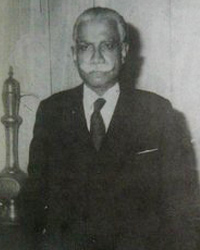 Muhammad Ataul Ghani (MAG) Osmani (1 Sept 1918 - 16 Feb 1984) Commander-in-Chief (C-in-C) of Bangladesh Forces during the Bangladesh Liberation War of 1971. Popularly referred to as 'Bongabir' (Brave Bengali) General Osmani. Born in Dayamir, Sylhet. Fought in WWII in Burma for British Indian Army (1939-1947). Shifted to Pakistani Army after 1947 partition and became a Colonel. Fought internally with superiors for rights of Bengali soliders. Joined Awami League and was elected MNA in the 1970 Pakistan general elections from Sylhet. Bangladesh Forces (military, air and navy) formed under his command during 1971 Muktijuddho. Retired in April 1972 as the first full General (four star) of Bangladesh Forces, which was replaced by Bangladesh Army, Bangladesh Navy and Bangladesh Air Force and three separate chiefs were selected. Thus 'General MAG Osmani' is the only historical name whose name appears first in the honour boards of the three services as C-in-C between 12 April 1971 to 7 April 1972. Controversially joined Khandaker Moshtaque Ahmed's cabinet as Defence Advisor after Sheikh Mujib's murder in 15 August 1975. Formed Jatiya Janata Party (1977-1984) and stood unsuccessfully against Ziaur Rahman for presidentship in 1978. Sylhet's Osmani International Airport (Osmani Antorjatik Biman Bondor), state-run hospital Sylhet Osmani Medical College and Hospital (popularly referred to as Osmani Hospital), Sylhet (MAG Osmani) Stadium, and (Osmani) Shishu Udyan named after him. Died as a bachelor, aged 66, on 16 February 1984 in St Bartholomew's Hospital, London, whilst receiving treatment for cancer. Buried next to mother in Shah Jalal Dargah, Sylhet with full military honours.
Muhammad Ataul Ghani (MAG) Osmani (1 Sept 1918 - 16 Feb 1984) Commander-in-Chief (C-in-C) of Bangladesh Forces during the Bangladesh Liberation War of 1971. Popularly referred to as 'Bongabir' (Brave Bengali) General Osmani. Born in Dayamir, Sylhet. Fought in WWII in Burma for British Indian Army (1939-1947). Shifted to Pakistani Army after 1947 partition and became a Colonel. Fought internally with superiors for rights of Bengali soliders. Joined Awami League and was elected MNA in the 1970 Pakistan general elections from Sylhet. Bangladesh Forces (military, air and navy) formed under his command during 1971 Muktijuddho. Retired in April 1972 as the first full General (four star) of Bangladesh Forces, which was replaced by Bangladesh Army, Bangladesh Navy and Bangladesh Air Force and three separate chiefs were selected. Thus 'General MAG Osmani' is the only historical name whose name appears first in the honour boards of the three services as C-in-C between 12 April 1971 to 7 April 1972. Controversially joined Khandaker Moshtaque Ahmed's cabinet as Defence Advisor after Sheikh Mujib's murder in 15 August 1975. Formed Jatiya Janata Party (1977-1984) and stood unsuccessfully against Ziaur Rahman for presidentship in 1978. Sylhet's Osmani International Airport (Osmani Antorjatik Biman Bondor), state-run hospital Sylhet Osmani Medical College and Hospital (popularly referred to as Osmani Hospital), Sylhet (MAG Osmani) Stadium, and (Osmani) Shishu Udyan named after him. Died as a bachelor, aged 66, on 16 February 1984 in St Bartholomew's Hospital, London, whilst receiving treatment for cancer. Buried next to mother in Shah Jalal Dargah, Sylhet with full military honours.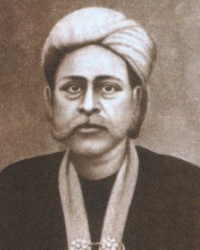 Hason Raja (1854 - 1922) Zamindar, mystic & poet. Born in Sunamganj.
Hason Raja (1854 - 1922) Zamindar, mystic & poet. Born in Sunamganj.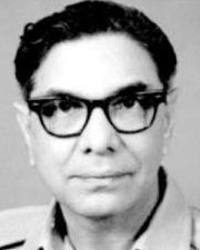 M. A. (Mohammad Abdur) Rab (1919 - 1975) Bir Uttam. Assistant Commander-in-Chief of Liberation war and first Army Chief of Bangladesh. Born in village of Khagaura, Baniachang thana, Sylhet. Founded the Muktijoddha Kalyan Trust and ran it successfully for years. Former MP. Chairman of the governing body of International Medical College. Died a bachelor on 14 November 1975 at the Combined Military Hospital, Dhaka, after suffering from ailments including anemia. Buried in his village of Umednagar on the banks of Khowai River in Habiganj. http://www.thedailystar.net/newDesign/news-details.php?nid=182371
M. A. (Mohammad Abdur) Rab (1919 - 1975) Bir Uttam. Assistant Commander-in-Chief of Liberation war and first Army Chief of Bangladesh. Born in village of Khagaura, Baniachang thana, Sylhet. Founded the Muktijoddha Kalyan Trust and ran it successfully for years. Former MP. Chairman of the governing body of International Medical College. Died a bachelor on 14 November 1975 at the Combined Military Hospital, Dhaka, after suffering from ailments including anemia. Buried in his village of Umednagar on the banks of Khowai River in Habiganj. http://www.thedailystar.net/newDesign/news-details.php?nid=182371 Abdul Malek (Born 1 Dec 1929) Cardiologist and National Professor of Bangladesh. Former Brigadier. Passed matriculation from Sylhet Government Pilot High School (1947), intermediate from MC College, Sylhet (1949, getting 11th position in whole Pakistan), MBBS from Dhaka Medical College (1954), one of only 5 students to do so. Pakistan Army Medical Corps (1955) and travelled to UK and got Membership of the Royal College of Physicians from Glasgow (1964), and received higher training in Cardiology at Hammersmith Hospital, Post Graduate Medical School London and some other hospitals in UK (1964 - 1966). First cardiologist of newly formed Pakistan in 1947. Established first Cardiac unit in Pakistan at Military Hospital Rawalpindi in March 1966 and carried out first open heart surgery in Pakistan (March 1970) in this cardiac unit. For this achievement, he was awarded Nationally and was promoted as Lieutenant Colonel. Joined Institute of Post Graduate Medicine and Research, Dhaka (now Bangabandhu Sheikh Mujib Medical University) in June 1970 and established cardiac unit there. Served as Professor of Cardiology (1970 - 1978), founder director and professor of National Institute of Cardiovascular Diseases, Dhaka (1978 - 1989). The first open heart surgery in Bangladesh was done on 18 September 1981 in this institution. Founded National Heart Foundation of Bangladesh (1978). Adviser to various presidents including President Ayub Khan and Sheikh Mujibur Rahman. Various high profile position and membership including Expert Panel Committee of World Health Organization (WHO) on Cardiovascular Disease (1976 - 2000), Vice-President of Asian Pacific Society of Cardiology (1994 - 1999), founder president of Bangladesh Cardiac Society (1980 - 2005), Honorary Secretary General of National Heart Foundation of Bangladesh, and many more. Fellow of Royal College of Physicians of Edinburgh Scotland, Bangladesh College of Physicians & Surgeons, American College of Cardiology and American College of Chest Physicians (USA). Awarded Swadhinata Purushkar (Independence Day Award, 2004) and designated 'National Professor' (2006) by Government of Bangladesh. Wrote three books 'Alor Poth' and 'Jiboner Kichhu Katha' and 'Jibon, Jagot Safolota'. Born in village of Paschim Bhag, South Surma upazilla, Sylhet. Son of Moulvi Furkan Ali and Syeda Nurun Nesa Khatun. Wife Ashrafunnesa Khatun is a social worker, daughter Fazilatunnesa an eminent cardiologist and Senior Chief Consultant at National Heart Foundation Hospital & Research Institute, Dhaka, son Masud Malik an industrialist and another son Manzur an Union Researcher.
Abdul Malek (Born 1 Dec 1929) Cardiologist and National Professor of Bangladesh. Former Brigadier. Passed matriculation from Sylhet Government Pilot High School (1947), intermediate from MC College, Sylhet (1949, getting 11th position in whole Pakistan), MBBS from Dhaka Medical College (1954), one of only 5 students to do so. Pakistan Army Medical Corps (1955) and travelled to UK and got Membership of the Royal College of Physicians from Glasgow (1964), and received higher training in Cardiology at Hammersmith Hospital, Post Graduate Medical School London and some other hospitals in UK (1964 - 1966). First cardiologist of newly formed Pakistan in 1947. Established first Cardiac unit in Pakistan at Military Hospital Rawalpindi in March 1966 and carried out first open heart surgery in Pakistan (March 1970) in this cardiac unit. For this achievement, he was awarded Nationally and was promoted as Lieutenant Colonel. Joined Institute of Post Graduate Medicine and Research, Dhaka (now Bangabandhu Sheikh Mujib Medical University) in June 1970 and established cardiac unit there. Served as Professor of Cardiology (1970 - 1978), founder director and professor of National Institute of Cardiovascular Diseases, Dhaka (1978 - 1989). The first open heart surgery in Bangladesh was done on 18 September 1981 in this institution. Founded National Heart Foundation of Bangladesh (1978). Adviser to various presidents including President Ayub Khan and Sheikh Mujibur Rahman. Various high profile position and membership including Expert Panel Committee of World Health Organization (WHO) on Cardiovascular Disease (1976 - 2000), Vice-President of Asian Pacific Society of Cardiology (1994 - 1999), founder president of Bangladesh Cardiac Society (1980 - 2005), Honorary Secretary General of National Heart Foundation of Bangladesh, and many more. Fellow of Royal College of Physicians of Edinburgh Scotland, Bangladesh College of Physicians & Surgeons, American College of Cardiology and American College of Chest Physicians (USA). Awarded Swadhinata Purushkar (Independence Day Award, 2004) and designated 'National Professor' (2006) by Government of Bangladesh. Wrote three books 'Alor Poth' and 'Jiboner Kichhu Katha' and 'Jibon, Jagot Safolota'. Born in village of Paschim Bhag, South Surma upazilla, Sylhet. Son of Moulvi Furkan Ali and Syeda Nurun Nesa Khatun. Wife Ashrafunnesa Khatun is a social worker, daughter Fazilatunnesa an eminent cardiologist and Senior Chief Consultant at National Heart Foundation Hospital & Research Institute, Dhaka, son Masud Malik an industrialist and another son Manzur an Union Researcher.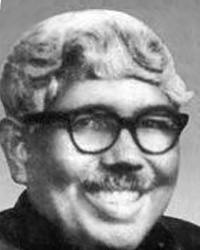 Govinda Chandra Dev (1907 - 1971) Professor of Philosophy at the University of Dhaka. Born in Beani Bazaar, Sylhet. He was executed in 1971 by the Pakistan Army along with 10 other teachers in 25th March Dhaka University Massacre as part of a plan to eliminate the Bangladeshi intelligentsia.
Govinda Chandra Dev (1907 - 1971) Professor of Philosophy at the University of Dhaka. Born in Beani Bazaar, Sylhet. He was executed in 1971 by the Pakistan Army along with 10 other teachers in 25th March Dhaka University Massacre as part of a plan to eliminate the Bangladeshi intelligentsia.  M. A. (Mahbub Ali) Khan (- 6 Aug 1984) Chief of Bangladesh Navy. Also acted as Minister of Communication of Bangladesh Government. Daughter Dr. Zubaida Rahman is married to Bangladesh Nationalist Party (BNP) senior vice-president Tarique Rahman, son of Ziaur Rahman. Died of heart attack after he fall sick when he was supervising rescue of a F-27 aircraft of Bangladesh Biman which crushed while landing at Dhaka Kurmitola Airport.
M. A. (Mahbub Ali) Khan (- 6 Aug 1984) Chief of Bangladesh Navy. Also acted as Minister of Communication of Bangladesh Government. Daughter Dr. Zubaida Rahman is married to Bangladesh Nationalist Party (BNP) senior vice-president Tarique Rahman, son of Ziaur Rahman. Died of heart attack after he fall sick when he was supervising rescue of a F-27 aircraft of Bangladesh Biman which crushed while landing at Dhaka Kurmitola Airport.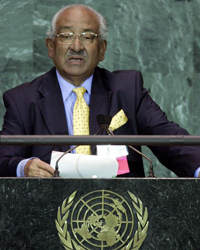 Md. Saifur Rahman (6 Oct 1932 – 5 Sept 2009) Longest serving (12 years) Finance Minister of Bangladesh. Member of BNP (Bangladesh Jatiotabadi/Nationalist Party). Born in village of Baharmardan in Moulvi Bazar district. Initially held Trade & Commerce Minister for 3 years. Vice-president of the Dhaka University's Salimullah Muslim Hall during 1952 Basha Andolan. Graduated (1953) with a B.Com (Hons). Prolific Chartered Accountant - qualified from Institute of Chartered Accountants in England & Wales. President of the Institute of Chartered Accountants of Bangladesh, Bangladesh Institute of Law and International Affairs, and United Nations Association of Bangladesh. Presided over the golden jubilee conference of World Bank and International Monetary Fund as elected governor at Madrid, Spain in 1994. Founded multiple educational institutions such as Sylhet Agricultural University, Sylhet Teacher's Training College, and Sylhet Engineering College. Awarded Ekushey Padak (2005). Died in a road crash on 5 September 2009 in Brahmanbaria District on his way to Dhaka from his home. A total of 5 janazah prayers were held for him and BNP held 3-day mourning for the passing.
Md. Saifur Rahman (6 Oct 1932 – 5 Sept 2009) Longest serving (12 years) Finance Minister of Bangladesh. Member of BNP (Bangladesh Jatiotabadi/Nationalist Party). Born in village of Baharmardan in Moulvi Bazar district. Initially held Trade & Commerce Minister for 3 years. Vice-president of the Dhaka University's Salimullah Muslim Hall during 1952 Basha Andolan. Graduated (1953) with a B.Com (Hons). Prolific Chartered Accountant - qualified from Institute of Chartered Accountants in England & Wales. President of the Institute of Chartered Accountants of Bangladesh, Bangladesh Institute of Law and International Affairs, and United Nations Association of Bangladesh. Presided over the golden jubilee conference of World Bank and International Monetary Fund as elected governor at Madrid, Spain in 1994. Founded multiple educational institutions such as Sylhet Agricultural University, Sylhet Teacher's Training College, and Sylhet Engineering College. Awarded Ekushey Padak (2005). Died in a road crash on 5 September 2009 in Brahmanbaria District on his way to Dhaka from his home. A total of 5 janazah prayers were held for him and BNP held 3-day mourning for the passing.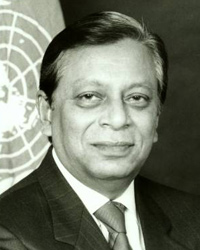 Humayun Rashid Choudhury (1928 - 2001) Former Speaker of Jatiya Sangsad (1996 - 2001). Elected president of the 41st session of the UN General Assembly in 1986. Graduated from Aligarh Muslim University (1947) and Fletcher School of Law and Diplomacy in Massachusetts, USA. During Muktijuddho he served as the Chief of the Bangladesh Mission in New Delhi in 1971-1972 during which he negotiated the recognition of Bangladesh by over 40 countries. Minister of Foreign Affairs (1985-1986) in President Ershad's cabinet. Awarded the Mahatma Gandhi Peace Prize (1984) by College of William and Mary, Virginia, United States, in recognition of his contribution to world peace through his diplomatic activities. Fluent in Bengali, English, Urdu, French and Italian, and had a working knowledge of Arabic, Spanish, Portuguese, German and Indonesian. Died with heart attack in Dhaka on 10 July 2001.
Humayun Rashid Choudhury (1928 - 2001) Former Speaker of Jatiya Sangsad (1996 - 2001). Elected president of the 41st session of the UN General Assembly in 1986. Graduated from Aligarh Muslim University (1947) and Fletcher School of Law and Diplomacy in Massachusetts, USA. During Muktijuddho he served as the Chief of the Bangladesh Mission in New Delhi in 1971-1972 during which he negotiated the recognition of Bangladesh by over 40 countries. Minister of Foreign Affairs (1985-1986) in President Ershad's cabinet. Awarded the Mahatma Gandhi Peace Prize (1984) by College of William and Mary, Virginia, United States, in recognition of his contribution to world peace through his diplomatic activities. Fluent in Bengali, English, Urdu, French and Italian, and had a working knowledge of Arabic, Spanish, Portuguese, German and Indonesian. Died with heart attack in Dhaka on 10 July 2001.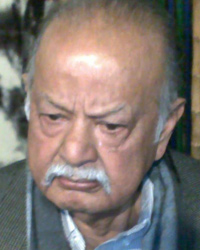 C. R. (Chitta Ranjan) Dutta (Born 1 Jan 1927) Bir Uttam. Sector 5 (Sylhet) Commander during 1971 Mukhtijuddho. Formed the Sector Commanders Forum with other prominent members from Bangladesh Liberation War. A leader of Bangladesh Hindu-Buddhist-Christian Unity Council (BHBCUC).
C. R. (Chitta Ranjan) Dutta (Born 1 Jan 1927) Bir Uttam. Sector 5 (Sylhet) Commander during 1971 Mukhtijuddho. Formed the Sector Commanders Forum with other prominent members from Bangladesh Liberation War. A leader of Bangladesh Hindu-Buddhist-Christian Unity Council (BHBCUC).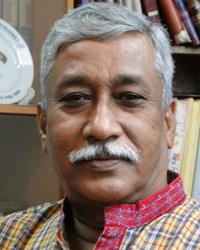 Azizur Rahman (Born ) Bir Uttam. Sub-sector Commander of Sector 3 (Sylhet) during 1971 Mukhtijuddho. Graduated from Habiganj Government High College (1959). Joined the then Pakistan Army in 1966 and fought against them five years later to liberate Bangladesh. Left Bangladesh Army in 1999.
Azizur Rahman (Born ) Bir Uttam. Sub-sector Commander of Sector 3 (Sylhet) during 1971 Mukhtijuddho. Graduated from Habiganj Government High College (1959). Joined the then Pakistan Army in 1966 and fought against them five years later to liberate Bangladesh. Left Bangladesh Army in 1999.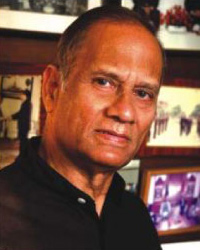 Mainul Hossain Chowdhury (1940 - 2010) Bir Bikrom. Commander of the second Bengal Regiment of Z Force during the War of Liberation in 1971. Ex Industries, Post and Telecommunications and Home Adviser of the caretaker government in 2001. Led ‘guard of honour’ given to Sheikh Mujibur Rahman on his return home from Pakistan jail on 10 January 1972. Died of cancer in Square Hospital, Dhaka. Left behind one son & one daughter.
Mainul Hossain Chowdhury (1940 - 2010) Bir Bikrom. Commander of the second Bengal Regiment of Z Force during the War of Liberation in 1971. Ex Industries, Post and Telecommunications and Home Adviser of the caretaker government in 2001. Led ‘guard of honour’ given to Sheikh Mujibur Rahman on his return home from Pakistan jail on 10 January 1972. Died of cancer in Square Hospital, Dhaka. Left behind one son & one daughter.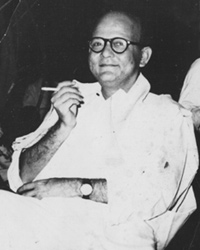 Syed Mujtaba Ali (13 Sept 1904 - 11 Feb 1974) Author, academician, scholar and linguist. Born in Karimganj (now part of Assam, India). Mother tongue was Bengali but he knew 15 languages including French, German, Italian, Arabic, Persian, Urdu, Hindi, Sanskrit, Marathi, Gujarati, Pashtu, English and several dialects of Bengali.
Syed Mujtaba Ali (13 Sept 1904 - 11 Feb 1974) Author, academician, scholar and linguist. Born in Karimganj (now part of Assam, India). Mother tongue was Bengali but he knew 15 languages including French, German, Italian, Arabic, Persian, Urdu, Hindi, Sanskrit, Marathi, Gujarati, Pashtu, English and several dialects of Bengali. 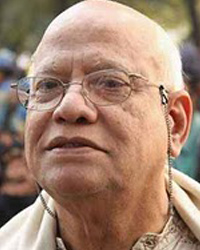 Abul Maal Abdul Muhith (Born 6 Oct 1934) Finance Minister of Bangladesh Government since January 2009. Published 21 books on different subjects including administrative and liberation war affairs. Qualified with first class first in B.A (Hons.) in English literature from Dhaka University (1954). Also studied at Oxford University and received MPA Degree from Harvard University (1963-64).
Abul Maal Abdul Muhith (Born 6 Oct 1934) Finance Minister of Bangladesh Government since January 2009. Published 21 books on different subjects including administrative and liberation war affairs. Qualified with first class first in B.A (Hons.) in English literature from Dhaka University (1954). Also studied at Oxford University and received MPA Degree from Harvard University (1963-64).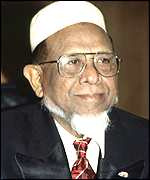 Abdus Samad Azad (15 Jan 1922 – 27 Apr 2005) First Foreign Minister after 1971 Independence. Born in Burakhali village, Sunamganj. Elected to Parliament 5 times representing Awami League. Agriculture Minister in 1973. Imprisoned after Sheikh Mujibur Rahman's killing in 1975 and released in 1978. Appointed Foreign Minister again (1996-2001) under Sheikh Hasina-led AL government. Died of stomach cancer in Dhaka hospital. Buried in Banani Koborstan (Graveyard), Dhaka.
Abdus Samad Azad (15 Jan 1922 – 27 Apr 2005) First Foreign Minister after 1971 Independence. Born in Burakhali village, Sunamganj. Elected to Parliament 5 times representing Awami League. Agriculture Minister in 1973. Imprisoned after Sheikh Mujibur Rahman's killing in 1975 and released in 1978. Appointed Foreign Minister again (1996-2001) under Sheikh Hasina-led AL government. Died of stomach cancer in Dhaka hospital. Buried in Banani Koborstan (Graveyard), Dhaka.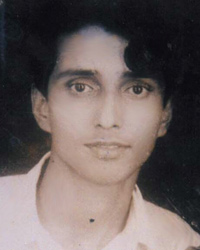 Dilwar Khan (Born 1 Jan 1937) Known as "Gono Manusher Kabi" (Poet of the People). Famous for describing struggles of the lower class through poems, short stories, essays and journal articles. Work include 'Shobdokor Matir Jogotay', 'Gighasha', 'Pubal Howha', 'Bangladesh Jonmo Na Nelay', 'Dilwar Rer Shadinotar Kobita', and 'Dui Meru, Dui Dana'. Received Bangla Academy Award (1980) and Ekushey Padak (2008).
Dilwar Khan (Born 1 Jan 1937) Known as "Gono Manusher Kabi" (Poet of the People). Famous for describing struggles of the lower class through poems, short stories, essays and journal articles. Work include 'Shobdokor Matir Jogotay', 'Gighasha', 'Pubal Howha', 'Bangladesh Jonmo Na Nelay', 'Dilwar Rer Shadinotar Kobita', and 'Dui Meru, Dui Dana'. Received Bangla Academy Award (1980) and Ekushey Padak (2008).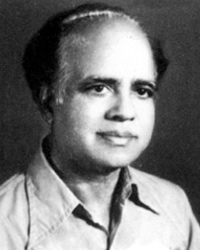 Shahed Ali (24 May 1925 - 7 Nov 2001) Educationist, cultural activist and a reputed author. Born at Mahmudpur village, Tahirpur Upazila, Sunamganj, Sylhet. Graduated from Sylhet MC College (1947) and passed MA in Bangla Language and Literature from Dhaka University (1950). One of the founders of Tamaddun Majlish which spearheaded 1947-1952 Bhasha Andolon. Wrote more than 50 books, amongst which he is acclaimed for the novel Hrday Nadi (1965) and six books of short fiction namely - Jibrailer Dana (1953), Ekai Samatale (1963), Sha'Nazar (1985), Atit Rater Kahini (1986), Amar Kahini (1987) and Natun Zamindar (1992). Bichar (1987), his only playlet, is admired in drama circles. Recipient of a number of awards, prizes and medals such as Bangla Academy Award (1964), Tamgha-i -Imtiaz (1969), Ekushey Padak (1989).
Shahed Ali (24 May 1925 - 7 Nov 2001) Educationist, cultural activist and a reputed author. Born at Mahmudpur village, Tahirpur Upazila, Sunamganj, Sylhet. Graduated from Sylhet MC College (1947) and passed MA in Bangla Language and Literature from Dhaka University (1950). One of the founders of Tamaddun Majlish which spearheaded 1947-1952 Bhasha Andolon. Wrote more than 50 books, amongst which he is acclaimed for the novel Hrday Nadi (1965) and six books of short fiction namely - Jibrailer Dana (1953), Ekai Samatale (1963), Sha'Nazar (1985), Atit Rater Kahini (1986), Amar Kahini (1987) and Natun Zamindar (1992). Bichar (1987), his only playlet, is admired in drama circles. Recipient of a number of awards, prizes and medals such as Bangla Academy Award (1964), Tamgha-i -Imtiaz (1969), Ekushey Padak (1989).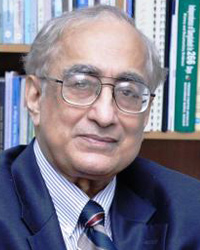 Jamilur Reza Choudhury (Born 1941) Vice Chancellor of University of Asia Pacific and Former Professor of Civil Engineering, BUET. Graduated from BUET (1963) and became a lecturer in the Civil Engineering department in the same year. Received M.Sc. Engineering Degree in Advanced Structural Engineering and Ph. D. from University of Southampton (1968). Primary engineer of Padma bridge. A former Adviser to the Caretaker Government of Bangladesh.
Jamilur Reza Choudhury (Born 1941) Vice Chancellor of University of Asia Pacific and Former Professor of Civil Engineering, BUET. Graduated from BUET (1963) and became a lecturer in the Civil Engineering department in the same year. Received M.Sc. Engineering Degree in Advanced Structural Engineering and Ph. D. from University of Southampton (1968). Primary engineer of Padma bridge. A former Adviser to the Caretaker Government of Bangladesh. 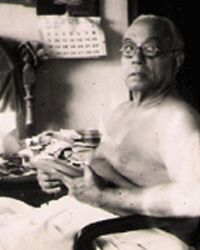 Sundari Mohan Das () http://sundarimohan.org
Sundari Mohan Das () http://sundarimohan.org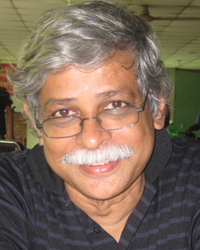 Muhammed Zafar Iqbal (Born 1952) Popular author and journalist. Professor of Computer Science at Shahalal University of Science & Technology. Younger brother of famous author Humayun Ahmed.
Muhammed Zafar Iqbal (Born 1952) Popular author and journalist. Professor of Computer Science at Shahalal University of Science & Technology. Younger brother of famous author Humayun Ahmed.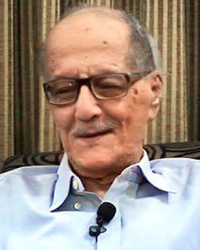 M. A. Majid () Former op-ed editor of Daily Dawn
M. A. Majid () Former op-ed editor of Daily Dawn Jalal Ahmad (Born 1959) Architect. Completed bachelor of architecture from Bangladesh University of Engineering and Technology (BUET) and established Diagram Architects (1983) with two other partners. Later started own architectural firm J. A. Architects (1997). Won the Mujib Nagar Memorial Open Design Competition (1984) and North South University Campus International Design Competition (2002). Founding member of architectural research group CHETANA (1983) along with eminent architect Muzharul Islam. Notable works include Scholastica School at Dhaka and Savar, Training And Resource Center BRAC at Faridpur, Rangpur and Bogra, and Dominic Residence in Tanzania. Awarded IAB Architect of the Year Award. General Secretary of Institute of Architects Bangladesh (IAB) and Vice president of Commonwealth Association of Architects.
Jalal Ahmad (Born 1959) Architect. Completed bachelor of architecture from Bangladesh University of Engineering and Technology (BUET) and established Diagram Architects (1983) with two other partners. Later started own architectural firm J. A. Architects (1997). Won the Mujib Nagar Memorial Open Design Competition (1984) and North South University Campus International Design Competition (2002). Founding member of architectural research group CHETANA (1983) along with eminent architect Muzharul Islam. Notable works include Scholastica School at Dhaka and Savar, Training And Resource Center BRAC at Faridpur, Rangpur and Bogra, and Dominic Residence in Tanzania. Awarded IAB Architect of the Year Award. General Secretary of Institute of Architects Bangladesh (IAB) and Vice president of Commonwealth Association of Architects. 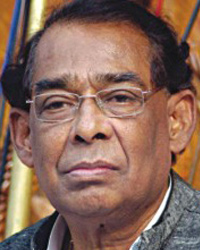 Suranjit Sengupta (Born ) MP
Suranjit Sengupta (Born ) MP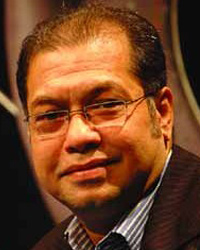 Subir Nandi (Born ) Playback Singer. Hits include 'Koto Je Tumake Behshehcii Bhalo', 'Bondhu Hote Chaye Tumar', 'Ekta Chilo Shunar Konna', and 'Oo Amar Ural Ponkhi Re'. Trained in classical music under Ustad Babar Ali Khan. National Film Award's Best Singer winner for films 'Mahanayak' and 'Shuvada'. Father was a doctor and medical officer. Born in Teliapara Tea Estate, Sylhet, along with 9 other siblings.
Subir Nandi (Born ) Playback Singer. Hits include 'Koto Je Tumake Behshehcii Bhalo', 'Bondhu Hote Chaye Tumar', 'Ekta Chilo Shunar Konna', and 'Oo Amar Ural Ponkhi Re'. Trained in classical music under Ustad Babar Ali Khan. National Film Award's Best Singer winner for films 'Mahanayak' and 'Shuvada'. Father was a doctor and medical officer. Born in Teliapara Tea Estate, Sylhet, along with 9 other siblings.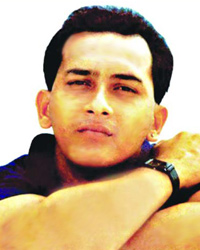 Salman Shah (aka Shahriar Chowdhury Imon) (1970 - 1996) Popular film actor. Mysterious death as discovered hanging from his ceiling home. Widely believed wife Samira behind Salman's death as he was romantically linked with co-actor Shabnur, though nobody ever held officially responsible. Buried in Shah Jalal Mazar, Sylhet.
Salman Shah (aka Shahriar Chowdhury Imon) (1970 - 1996) Popular film actor. Mysterious death as discovered hanging from his ceiling home. Widely believed wife Samira behind Salman's death as he was romantically linked with co-actor Shabnur, though nobody ever held officially responsible. Buried in Shah Jalal Mazar, Sylhet.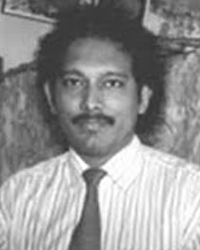 Kaiser Hamid (Born ) Former footballer gained fame in the 1980s and 1990s as a central defender for Mohammedan Sporting Club in Dhaka's domestic league. Represented Bangladesh national team. Received Bangladesh National Sports Award (2003).
Kaiser Hamid (Born ) Former footballer gained fame in the 1980s and 1990s as a central defender for Mohammedan Sporting Club in Dhaka's domestic league. Represented Bangladesh national team. Received Bangladesh National Sports Award (2003). Dineshchandra Datta () Professor of English
Dineshchandra Datta () Professor of English Harun Ahmed Chowdhury ( - ) Bir Uttom
Harun Ahmed Chowdhury ( - ) Bir Uttom M. R. Chowdhury ( - ) Bir Uttom
M. R. Chowdhury ( - ) Bir Uttom Ejaz Ahmed Choudhury ( - ) Bir Uttom A war hero of 3 Sector
Ejaz Ahmed Choudhury ( - ) Bir Uttom A war hero of 3 Sector Imamuzzaman ( - ) Bir Bikrom
Imamuzzaman ( - ) Bir Bikrom
Important information, tips, hints, ...ittadhi
- Sylhet city's official website: www.sylhetcitycorporationbd.com
- Sylhet district's official website: www.dcsylhet.gov.bd
- Osmani International Airport telephone: 741532-42
- Hospital telephone:
- Railway: 843201-10
- Police Control Room: 639022
- Shops opening hours: 11am - 7pm everyday except Friday when they're closed.
- Coach station: located near Kean Bridge.
- Shah Paran mazar: located approximately 3 miles east of city centre. There's no top class hotel nearby so most people wishing to visit it for few days will have to travel into the city for residence.
- Traffic manned by police: traffic warden operate busy crossroads e.g. Amberkhana Point, Chowatta Point. There are very few or no traffic lights.
May Allah bless Sylhet and our People. Ameen.


